
Scenery like this is common place on the Oregon and Washington coastline. This one is Ruby beach with its crowd of sea-stacks.
adidas’s North American headquarters is situated on N. Greeley Avenue in Portland, Oregon. If you were to drive straight out of Greeley and then further west on Hwy 26 for another 80 miles or so, you’ll hit land’s end, or the mighty Pacific ocean. The entire coastline is dotted with magnificent rock formations and beaches, battered by millions of year’s worth of weather elements, bird droppings and angry waves.
All these places are great to spend a lazy afternoon on. There’s plenty of variety too; some stretches are sandy, while others are gravelly, with giant logs of driftwood deposited by rivers flowing from deep inside the enchanting Pacific Northwest. The water is always freezing, yet proves to be a poor deterrent for people who come and visit. If they’re lucky, they might find an orange Sea Star to take a picture of.
It is inevitable that you’ll strike up a conversation with one of the locals, and it is also very likely that your new friend might point at a huge monolith and say something like, ‘this is the most photographed rock in the United States.’
You realize that he means it; but you also know that can’t be possibly true. Most of these collosal sea stacks are formidable geological formations and truly deserving of local pride, and it could be the most photographed rock in Oregon and Washington state. Ok, maybe on the entire length of West Coast. But the continental United States? Nah.
So when adidas says things like that the Ultra Boost is the ‘greatest running shoe ever’, it might be because of two reasons. The first is genuine chest thumping anchored in the knowledge and pride that they have a stellar thing going with the Boost foam. Similar to how our friend on Oregon’s rocky shore felt, and hence the former analogy.
The second could be synthetic (and intentional) trumpet blowing, meant to allay the angst of shareholders who want adidas to perform better both on the Wall Street and North America. adidas urgently needs a slew of products which can command not only coolness but also respect, and what better way than to pin your hopes on the successful Boost platform?
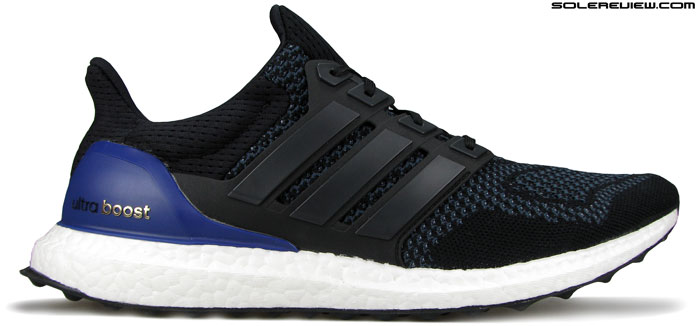
Might not be the greatest thing ever made out of mesh, foam and rubber, but still ends up being pretty good.
You might think we’re dissing the Ultra Boost; we’re not. The newest $180 intro is a very good shoe, blending two of adidas’s newest and most marketeable – the Primeknit upper construction and a high volume Boost midsole. But throwing around the ‘greatest’ hyperbole isn’t exactly the smartest move; there is no running shoe in the world which is a universal fit for all.
Like most running shoes, there are a number of things we like about the Ultra, at the same time counter balanced with areas which could do with a leg-up. So calling a shoe ‘greatest’ is setting it up for a case of over-promise and under-deliver.
So far, adidas hasn’t made a strong showing of its Primeknit upper in its performance running line, except for the occasional release like the Primeknit Boost. The German sportswear giant is attempting to change that, with more releases making use of the knit upper. The Ultra Boost is one, and we’ve starting to seeing pictures of a Primeknit Boston Boost, so these are obvious clues hinting at the future shape of what may follow.
On some level, the Ultra Boost is similar to the Energy Boost 2. The two models can be compared on shared traits like a compressive upper, plastic midfoot cage and heel, and a prodigious chunk of exposed midsole hewn out of bouncy Boost foam. Even the plastic ‘Torsion’ shank dams up on the Ultra Boost’s medial heel the same way the EB-2 does. At the same time, the two differ on the quality of fit and cushioning behavior, and as always, we’ll talk about it at length before the sun goes down.
This might be a good time to momentarily touch upon the topic of the annual Energy Boost refresh. After being consistently refreshed for two years, there’s radio silence on whether a third iteration of the Energy Boost will follow. Is the Ultra Boost the replacement for Energy 2? That thought is not far fetched, for a couple of reasons. One, it looks like Primeknit (in its multiple avatars) is going to be featured on a lot more models going forward, and the Ultra kicks that journey off in style.
Secondly, the Energy Boost’s price was unchanged for two years at $160, and assuming there was a 5% retail price increase, the imaginary EB-3 would have been around $170. That would have placed it uncomfortably close to the Ultra, and would have made no merchandising sense at all. But if the $160 price point is eventually vacated, then there will be a huge pricing vacuum between the $130 Glide Boost and the Ultra. What adidas should do is to replace the Energy Boost with a new $150 model which will go head to head with competitors such as the Asics Nimbus 17, Nike Vomero, Brooks Glycerin and Saucony Triumph. Might also be a good idea to thrown in a ‘stability model’ while at it.
Coming to think of it, this is the first time we’ve come up close and personal with adidas Primeknit on solereview. We were always curious to find out how adidas Primeknit compares against Nike’s version, which by the way, comes in different iterations. Like the super compressive Nike 3.0 Flyknit, or the more easy going version on the Flyknit Lunar. For now, we can only judge Primeknit based on its use in the Ultra Boost, but as time goes by, we should be exposed to more variants.
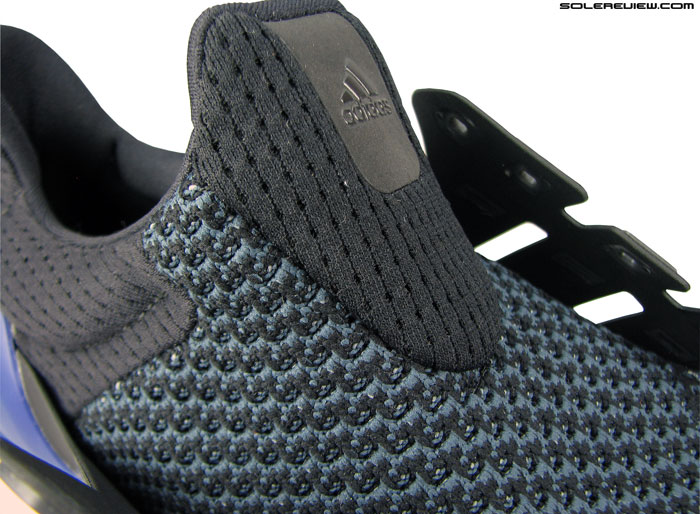
The Ultra has a half (ok, maybe 3/4th) Primeknit upper. Midfoot partially switches to another material, and so does the heel area.
The Ultra Boost upper isn’t pure Primeknit, but rather a hybrid which uses elastic-knit in forefoot and midfoot, and a bootie construction in the rear which relies on traditional stretch fabrics.
If you own or tried on a pair of Energy Boost 2, then it is easier to draw a parallel from a material standpoint; this is akin to Techfit stretch in the front and a traditionally designed rearfoot.
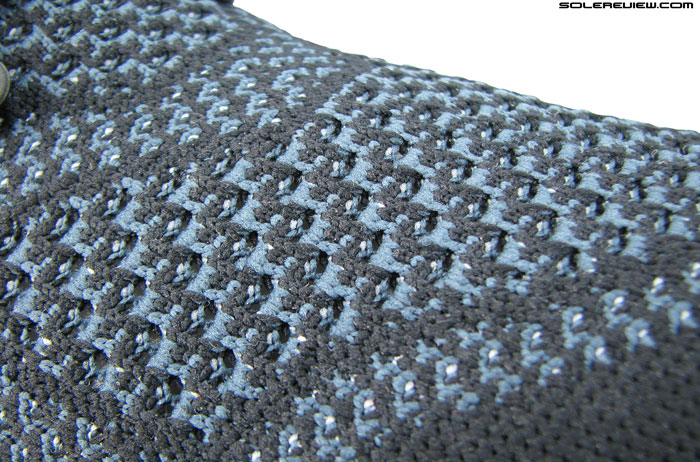
A large part of Ultra’s upper is made of Primeknit, an elastic panel which conforms to your foot shape.
Like engineered meshes, the single piece Primeknit has multiple zones of stretch. Meaning, it feels more elastic in places like the top of forefoot, while the edges and toe bumper have a closed knit construction for better structural support.
Ventilation is also based on zones; the forefoot top is more porous and breathable, which also makes it more accommodating to stretching.
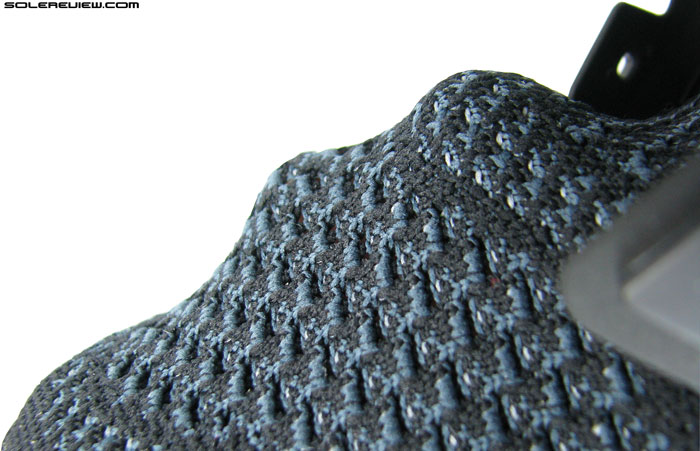
We found out that ventilated knit area is much stretchable, based on our patent pending “push-up-with-your-fingers” test.
Push up on that area with your fingers, and one gets an idea of compression levels. The elasticity is more relaxed than tech-fit, and also shoes such as the Nike Free Flyknit. But the forefoot isn’t 100% Primeknit.
There is an internal toe stiffener lined beneath the fabric, and that’s something you can feel when you wear the shoe or when simply running your fingers along the inside edges. It’s hard to see it from the outside, so we’ve included a picture of that later in the review.
The Ultra Boost upper abandons the use of a regular tongue and collar design, and instead adopts a full bootie construction, which means that the walls of the rearfoot opening run broken. To make it easier for the foot to slide in, the collar fabrics are elasticated, coupled with an exaggerated Achilles area.
The mega pull tab is a visual oddity yet functionally effective, and comes in very handy when putting the shoe on. Talk about reflectivity, and there isn’t much to show for. There’s the tongue label which semi-shines in low light, and that’s that.
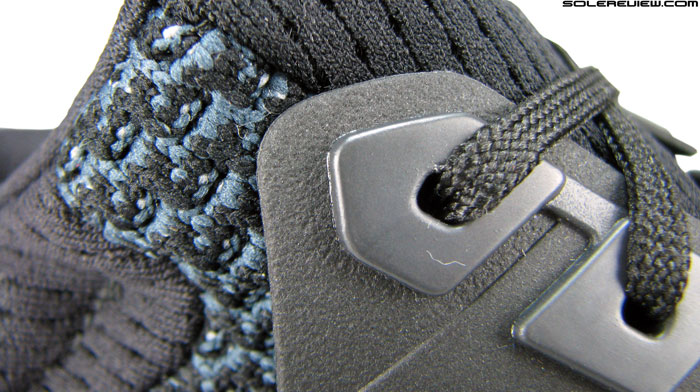
With the upper portion of tongue and midfoot being padded, the plastic edges are of little danger. The fixed opening collar also negates the need for a fifth lacing eyelet.
Collar is comfortably cushioned with foam, and so is the upper part of the tongue. Actually, the entire upper lining of the midfoot is padded. This helps dull the lacing pressure and prevent the corners of the plastic cage from potentially rubbing over.
Speaking of the plastic cage, don’t you think the contrast is a bit odd? On one hand, the Primeknit’s solitary goal is to deliver an accommodating or custom level of fit, its elastic fibers shaping around the contours of the foot.
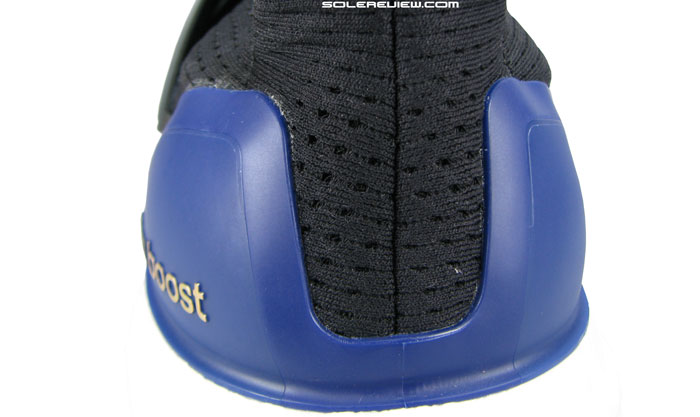
Midfoot cage attaches to the molded heel clip with an inwards flare. This plastic counter also cups under the heel edges. Leaving the Achilles area free was smart design thinking.
On the other hand, a hard plastic cage is the polar opposite of Primeknit, and it is as rigid as it gets. The forefoot and midfoot may be made of the elastic fabric, but practically speaking, the cage kind of dilutes the midfoot Primeknit experience. Midfoot lockdown is taken over by the thermoplastic cage and not the knit textile, and the piece joins a large heel clip with an inwards flare.
Here’s our take on why the Ultra Boost uses so much plastic on what could have been a lightweight upper with unadulterated stretch. We think that the Boost midsole is inherently unstable once the foam volume crosses a certain threshold, and that is why adidas uses one (or sometimes both) of the two things – a plastic midfoot and/or a midsole rim.
The Supernova Glide Boost feels the most balanced when it comes to cushioning and support, and it uses a firmer rim over the Boost midsole. The Energy Boost 2 used both the cage and rim; the adios, Boston and Tempo Boost all use harder midsole edges. In addition to all this, most performance running models need the Boost midsole to be formed with a ridge – meaning a narrower Boost section molded on a wider base. This little noticed (and intentional) design feature makes the shoe more stable.
What happens if you remove the cage, rim and midsole sculpting? You end up with something like the adidas Pure Boost, which was a really terrible running shoe. No stability at all. Boost might be a superb cushioning platform, but far from perfect on its own. It best performs only when teamed up with supplementary design features.
To reinforce our point, a Boost running shoe needs to feature at least one of the stability elements. Either a plastic cage with midsole ridging (Ultra Boost), or a harder support rim with midsole ridging (Glide Boost). In our opinion, the midsole rim is the lesser of the evils, providing support while keeping the Boost ride signature intact. We were never fond of the plastic midfoot in the first place, and running over 30 miles in the Ultra Boost has done nothing to change that impression.
The silver lining here is that the Ultra Boost’s inflexible midfoot surrounding isn’t as bad as Energy Boost’s. The design allows you to have a greater amount of control over fit pressure compared to the Energy.
You see, there were a couple of factors at play on the Energy Boost which made the midfoot cage feel so restrictive. It was stitched tight and flush to the compressive upper, so it felt and behaved like an inseparable part of the shoe. The pressure over medial midfoot was particularly noticeable, regardless of how you laced the shoe.
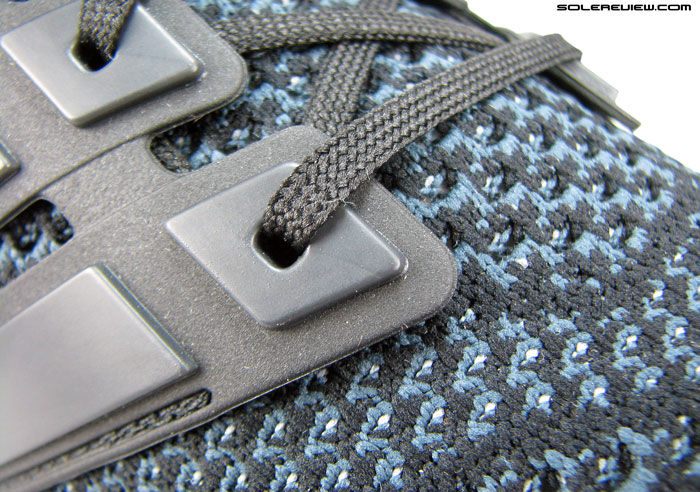
The plastic cage is stitched in the front, but the eyelets have a relative freedom of movement compared to Energy Boost.
On the Ultra Boost, the cage is stitched to the upper only in the front, where yes, the pressure feels slightly uncomfortable. But rest of the plastic has a floating structure and anchored only to the midsole edge. The first row of eyelets also rise up higher than their counterparts on the Energy Boost, giving them more liberty to move around at will.
The detached design helps the plastic cage dynamically adjust and move its position along with foot movement, and we think this was smart. You still feel the hard shell, but without the invasiveness of how Energy Boost felt.
A word of caution, though. The midfoot cage will become a problem if you fasten the laces too tight. So the key is to go easy on pulling those gold tipped laces, and keep things a bit relaxed.
Remember that the Ultra Boost has a sleeved upper, so let that do most of the midfoot lockdown instead of delegating that job to the TPU panel. This will also ease off top down lacing pressure.
Ultra Boost is short-laced, with only four rows of eyelets against a regular five or six. The chances are, you won’t miss the last row of cinching. The bootie sleeve like design of the tongue and collar delivers a level of wrap which few will find flaws with.
Plushness is foam packed under the lining, and the inwardly molded heel counter works together with the high Achilles lip to prevent heel slippage. It is worth underscoring that the plastic heel piece leaves the area running along the Achilles uncovered, a design aspect which runners with sensitive Achilles will love.
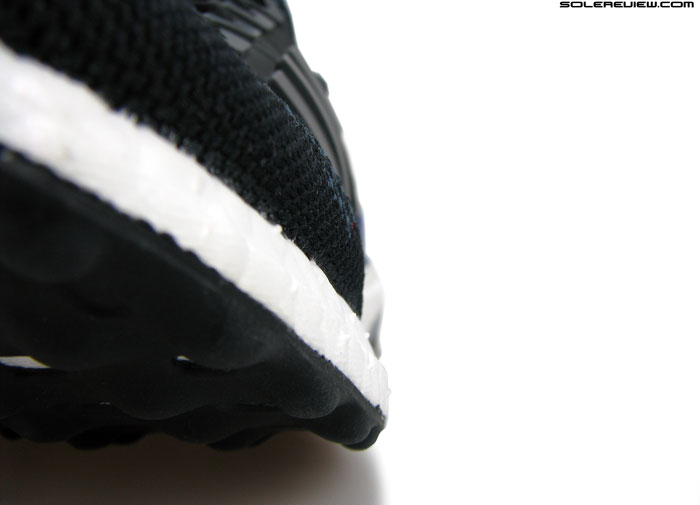
The removable insole reduces forefoot space, making it shallow. See that outward curve over the midsole edge? Part of that is the insole pushing out.
Upper forefoot is very shallow and has an extreme taper around the toe bumper. There’s less space inside the forefoot by default, and then the insole eats into whatever’s left. Like the Response Boost, the footbed sits on the midsole instead of in a cavity.
The net result is your big toe being pressed down by the Primeknit upper, though visually it looks like there’s plenty of space ahead of your toes. As far as sizing is concerned, we’d buy the exact same size as the Energy Boost Techfit.
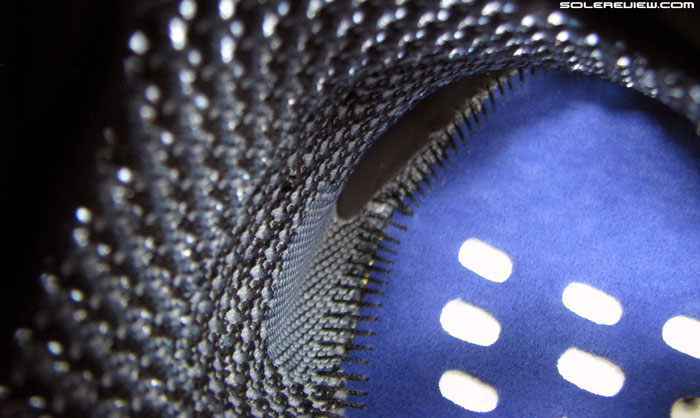
The Primeknit interior is smooth for the most part. Yet there’s an internal toe puff (see black portion in the center of this picture), which tends to catch on the small toe during barefoot use.
We did not find barefoot use of the Ultra Boost particularly comfortable, for two reasons. The super snug upper medially rubs against the small toe over time, and will end up in blisters or skin chafe.
There’s also an internal toe puff which has the tendency to catch on the small toe – you can see that in the image above (the black strip right in the front). With socks, there are no issues, and the upper feels smooth and seamless.

Primeknit forefoot has way more stretch than the Techfit fabric. Not a simple matter of how much space the upper has around the foot, but rather the fabric’s capacity to expand.
When compared to the Energy Boost, the Ultra forefoot feels much more roomy, or should we say, conducive to adjustment. There is no open space, yet the Primeknit upper is better able to expand and fit around the foot. The Ultra also has a lower toe spring, which we also think contributes to the relatively forgiving nature of the shallow toe-box.
One area where the compressive forefoot adds value is in enhancing ground feedback; the midsole front is much thinner than in the back, and the upper does a great job at driving a better connection between the foot and running surface. This design also makes the forefoot extremely flexible, easily the highest level among all the Boost models reviewed here.
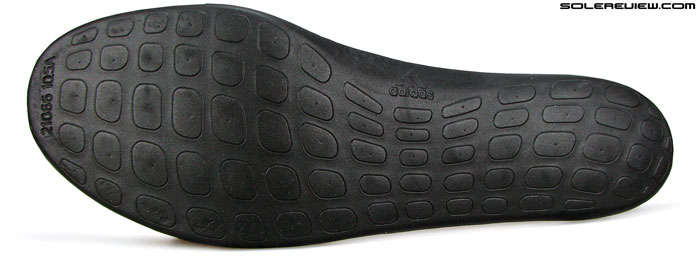
The other side of the compression molded EVA midsole. The last markings indicate a different base fit than other Boost models.
The last used is also different than EB-2’s, so that must be something to that too. If the last marking on the sockliner is anything to go by, then the Ultra Boost, Boston Boost, Energy Boost and Glide Boost all are based on different upper fit dimensions – at least on paper.
It is hard to accurately pinpoint specific differences just by wearing and trying to compare all, as materials and construction techniques differ (and hence influence fit) vastly.
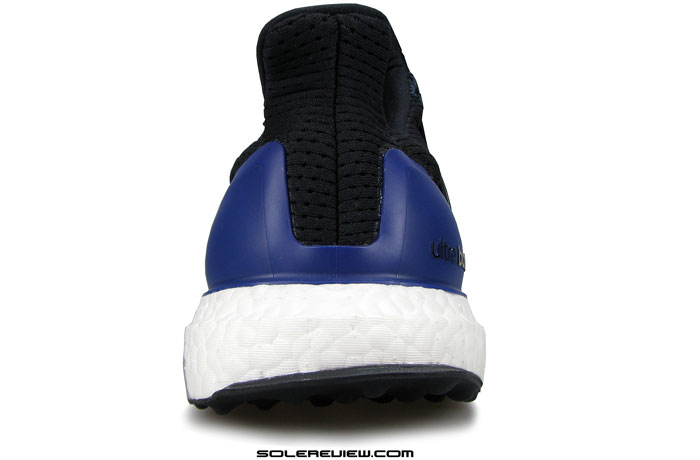
The Boost midsole is layered ice-cream sandwich style. Whitey Boost in the center, and harder bits on top and bottom. No EVA mixed in here.
Midsole design is fairly straightforward, and typical of how most Boost based models are assembled. The Ultra Boost differs slightly by not including any EVA bits. Much like the Pure Boost, the sandwiched layer is 100% Boost foam. A sharp ridge separates the upper and lower half of the Boost midsole, which results in a narrower section of foam molded on to a wider base.
Given the high volume of Boost and plastic use, the Ultra is not featherweight. It tips the scale at 333 grams or 11.74 oz for a half pair of US 11. Pretty much the median for traditional running shoes. To add some perspective, models like the Asics GT-2000 2, Brooks Ghost 6, Nike Vomero 9, and New Balance 1080 V5 weigh the same.
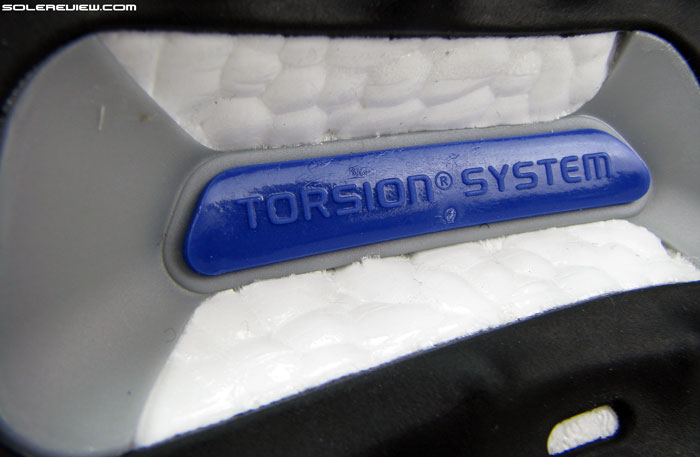
The plastic Torsion thing lies in a recessed cavity, it’s funnel shaped ends spreading up and outwards from there. For better splay and softer outsole feel? Maybe.
Ultra Boost comes with a Torsion shank – a plastic component which is attached to the underside of the foam midfoot. While we generally see a flat piece glued flush with the outsole, the footbridge here originates in a midsole cavity.
We’ve got a few theories around why this might be. One is that the stability could be helped by splaying of the open area, which should lower the center of gravity on weight loading. At the same time, the Torsion component sits closer to the foot that way, and helps increase the feel of midfoot stiffness. Also have this feeling that adidas designers might have wanted the Ultra to have a consistent soft feel from rear to front, and a flat Torsion shank could have spoiled the fun.
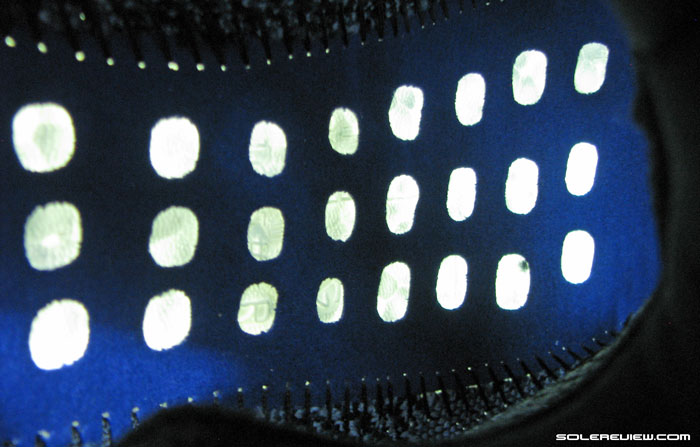
There are exposed areas on the outsole and strobel, so the Boost foam glows like a Christmas paper lamp under bright lights.
Closer to the upper, a perforated strobel separates the midsole and insole. The strobel is like what the footbed of PureBoost was; a sheet of synthetic leather with angular holes cut punched in.
Boost foam is exposed through these gaps, and if you were to hold the outsole against bright light, a part of the shine will illuminate the foam. This attests to the Boost foam’s expanded (and lighter density) construction, made possible by use of steam molded Polyurethane.
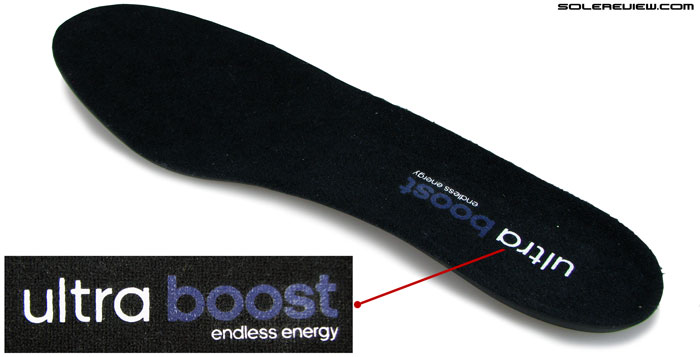
The insole is regular insertable type, but a little thinner than Energy Boost’s. More like what’s in the Boston 5.
A compression molded EVA insole is used along with the lattice-like strobel. Not as thick as the one on Energy Boost; more closer to the type used on Boston Boost. A smooth fabric lining on top, and a textured underside which mirrors the grid like design of the strobel and outsole.
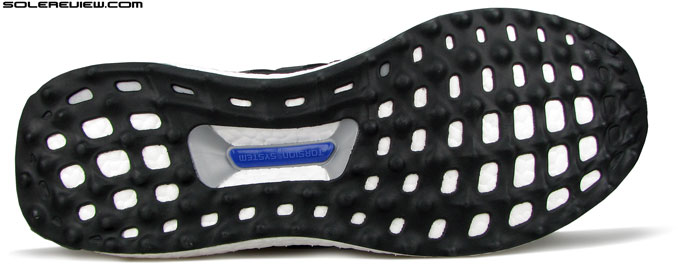
Not many pieces of rubber here, just a single latticed sheet clothes the bottom. The exposed windows help reduce weight and increases the ride softness and consistency.
adidas calls its outsole design ‘Sprintweb’, a single piece of soft rubber with rectangular perforations exposing the Boost midsole. Scores of rounded rubber nubs jut out of its surface, and they grip tenaciously at first.
But there’s a catch; the traction is amazing on asphalt only when new. As time and miles go by, the initial euphoria fades away, along with the lugs getting shredded down to their stubs.
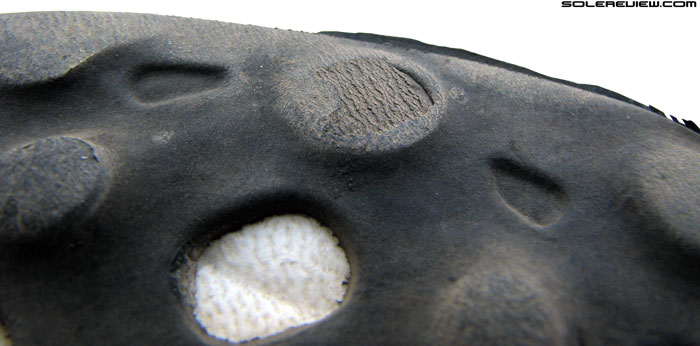
Soft rubber lugs meets immovable Asphalt, and quickly meet their demise. After just 30 miles, the once pointy things are razed to their very foundation.
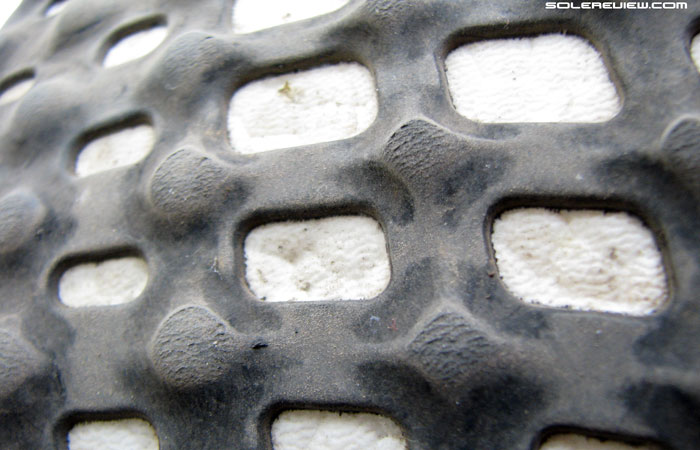
This wear pattern was for a rear-foot striker, but if you’re a forefoot landing type, expect these protuberances to fade into quick oblivion.
After just thirty miles, most will see the pointy bits completely wear down to their base around the footstrike area, which in our case happened to be the rearfoot. And if you’re forefoot striking, expect accelerated wear in the front. Even if you’re just using the forefoot as a transition area before toeing off, rapid wear still happens, as pictured above.
Based on our experience with many shoes, the rate of wear should subside once the nubs are fairly worn off and the outsole flattens out. But this rate of inital wear is completely unacceptable; why not make the outsole flat to begin with, then? While on topic, the Sprintweb outsole is no match for Continental or Adiwear rubber’s durability, and shoes like the Energy or Glide Boost will last much, much longer.
All that behind us, the most important question is – how does the Ultra Boost ride? Considering that the Boost foam is pretty standard as far as its cushioning behavior is concerned, does this $180 shoe do anything special which the $160 Energy or $130 Glide won’t?
The Ultra’s closest living relative is the Energy Boost 2, so we think that is a good reference to benchmark our ride experience against. We have quite a few thoughts to share with respect to how the Ultra performs, and perhaps the best way to articulate that is to break it down into three chunks – cushioning character, transition, and stability.
Cushioning behavior:
The Ultra Boost is soft, much more than lesser Boost models such as the Glide. The heel softness is comparable to the Energy Boost 2 , but with one major difference – the midsole is far more responsive. That is caused by two factors. If you were to look at the midsole heel top down, you will notice that a good portion of the Boost foam sticks outwards, along with the outsole lip.
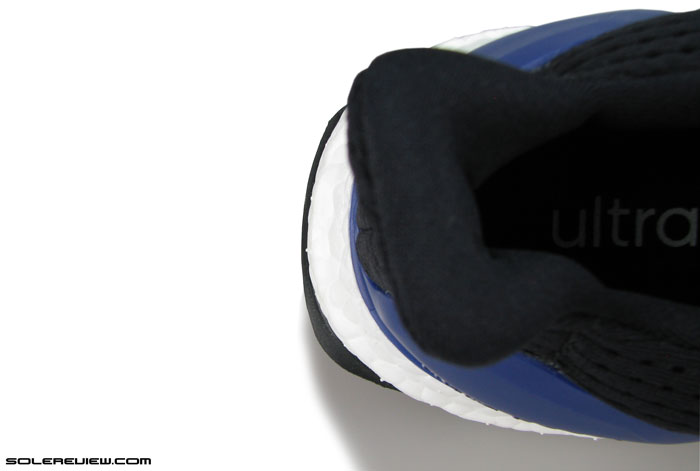
A fair bit of Boost Foam sticks outwards, causing the midsole to splay and flex longer on heel strike.
This is true even for the medial and lateral side of the heel, where the lower section of the Boost midsole spreads out wider. Secondly, a wider flare on lower midsole creates a greater contrast with the upper portion, which then becomes relatively narrower. In short, this was the case on the Energy Boost 2 too, but on the Ultra, this design aspect is accentuated.
We also noticed that the upper half of Ultra’s Boost foam midsole has a smooth texture, compared to a faint ribbing running over the lower section. Could not tell whether this makes a difference on cushioning, but just know that the Energy Boost’s midsole had ribbing going over the entire midsole.
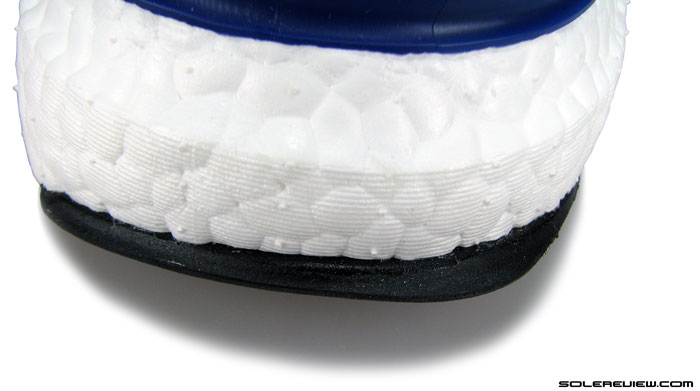
The Boost midsole is sculpted such so that the smooth upper portion is narrower than the ribbed base it sits on.
So with the extra foam sticking out and the midsole sculpting built in, a couple of things happen on rear-foot strike – a textbook example of cause and effect. Since there’s more Boost foam available for footstrike, the landing causes the midsole to slightly flex outwards, increasing the springback levels. Secondly, because of the way how the narrow section of Boost is ridged over a wider base, there is a distinct pistoning effect. The effect which has the narrower foam sink in and come back out soon after weight moves forward.
In simple words, it just feels like you’re squishing a larger amount of molded Boost globules under your foot compared to any other Boost running shoe.
Under the heel area, the Energy Boost 2 feels softer than the Ultra, and we can think of two reasons why that is. The insole used on the EB-2 is much thicker than Ultra’s and that makes part of the ride feel softer. The other part at play here is the sheer stack height and midsole design of the Energy Boost.
At its thickest point, the midsole height is greater on the Energy than the Ultra, and by lacking a wider base, foot-strikes on the Energy feel a bit one-dimensional. Personally, we prefer the more dynamic or layered cushioning character of the Ultra Boost.
The Ultra retains the signature ride character of adidas’s much touted midsole foam, but with a few tweaks, it manages to deliver a slightly different take on the experience.
Transition:
The thing to know about the Ultra Boost is that the front and rear part of the midsole work together as two separate halves. In the back, a very cushioned ride pampers your heel as explained in the cushioning breakout.
The landscape changes as the midsole tapers down to a thinner forefoot, where the focus changes to delivering a higher level of ground feel. It is still cushioned, yes, but a far cry from the last bus stop. The entire shoe nevers get firm anywhere – the perforated strobel and a similar soft rubber outsole allow the Boost foam to transition freely. And softly.
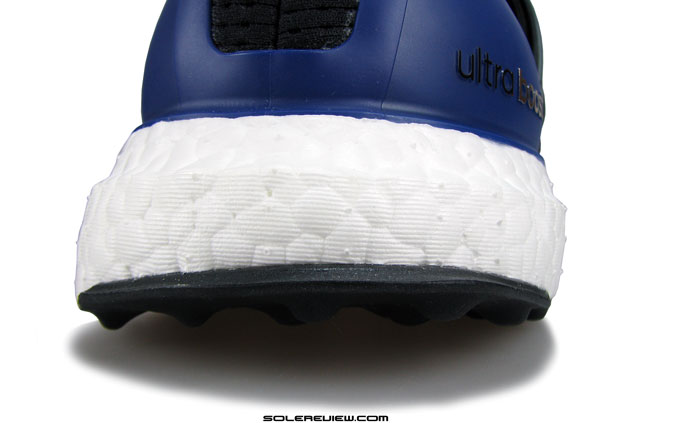
The front and rear midsole feel very different – soft vs. minimal respectively. An outsole bevel helps transitions for rear-foot/heel strikers.
So the transition isn’t effortless, and that is one of the reasons why the Ultra Boost won’t cut it as a shoe for speed-work. It’s definitely a shoe you can do training runs in, with distance no object. If you really need a fast shoe, better to have a pair of Boston 5 Boost to rotate with this fella.
Stability:
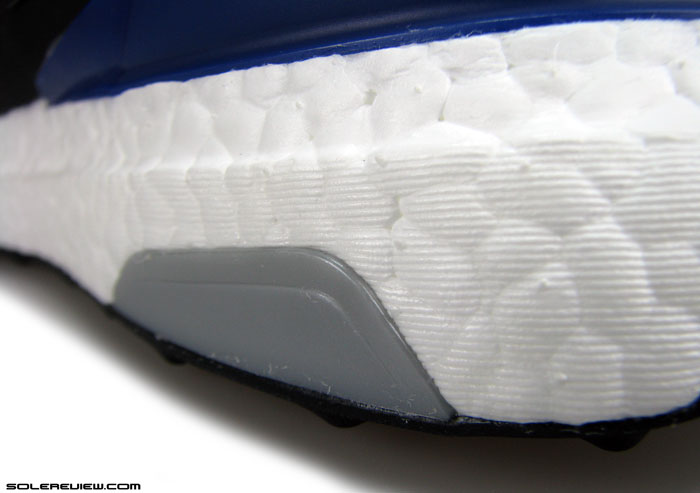
There are support elements like the medial Torsion dam and heel counter, yet the Ultra is a little more footroll friendly than the Energy or Glide Boost.
Last but not the least, is the topic of how the Ultra does on stability. The upper might be firmly anchored to a rigid midfoot cage and heel counter, but the midsole does not have the rim which forms a part of models such as the Glide and Energy Boost.
So the Ultra’s ride is a little more bouncy, and more susceptible to encouraging inward foot-roll. The scooped midsole (the part which pistons) helps with maintaining support, but it still feels a bit wobbly compared to Boost shoes constructed with midsole rims.
But at the same time, we have to remember that the Ultra Boost is very much a neutral shoe, and the midsole behavior is well within the boundaries of that. No harm done here, this shoe is no Pure Boost.
After having looked at the Ultra Boost from multiple wear-test angles, our opinion is as follows: The shoe has many things working for it, like the signature ride which is part of the Boost platform, an upper fit which feels snug yet comfortable, and transition quality which feels great for a shoe this cushioned. Yet areas like premature outsole wear, a squashy toe-box and the unwanted pressure from the midfoot cage make a dent in the German brand’s ‘greatest running shoe’ claim.
It is certainly better than the Energy Boost (except for the outsole durability part), that’s for sure. But then, one has to pay $180 for a fresh box of Ultra’s and that sets the bar very, very high. Anyone would expect a truly exceptional product under the circumstances, and we feel that the Ultra Boost still has some ground to cover before it can honestly be called great.
(Disclaimer: For this review, Solereview bought the shoe at full US retail price.)

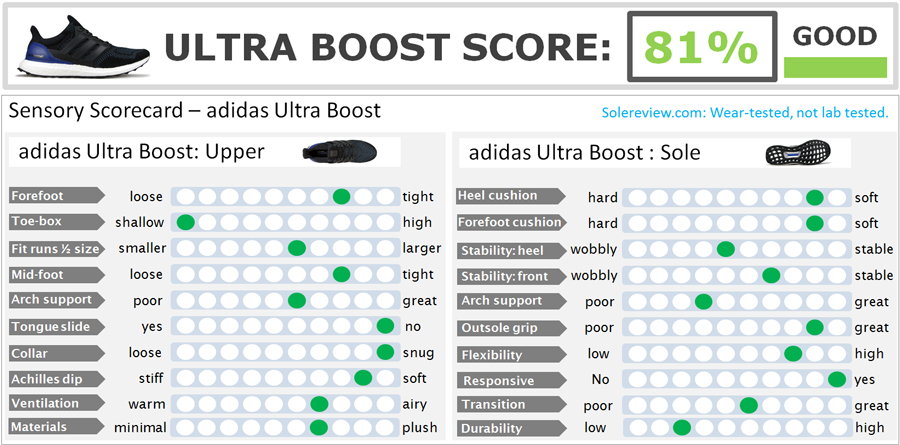
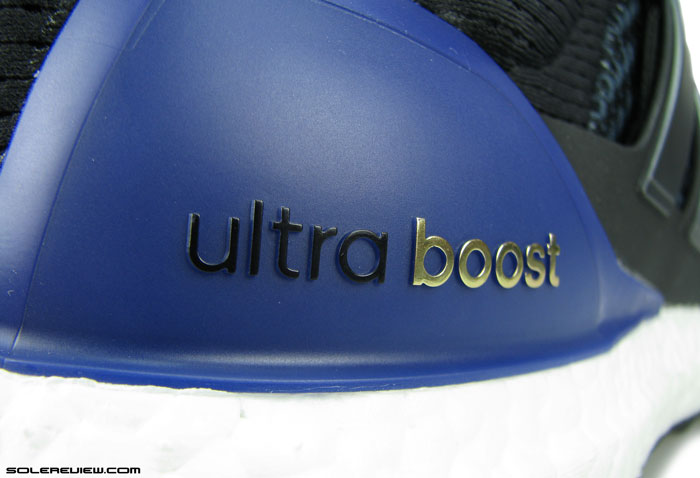
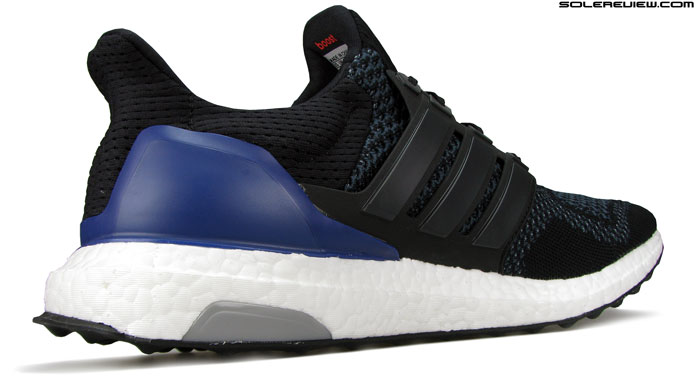
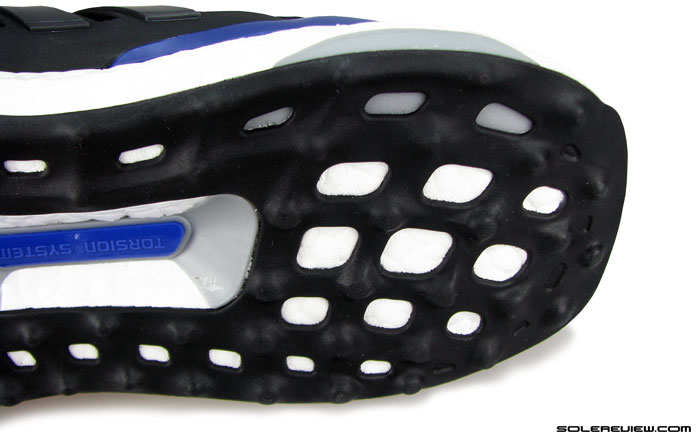
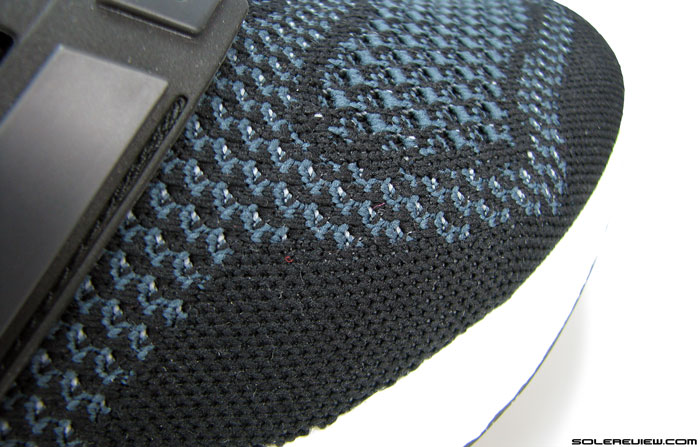
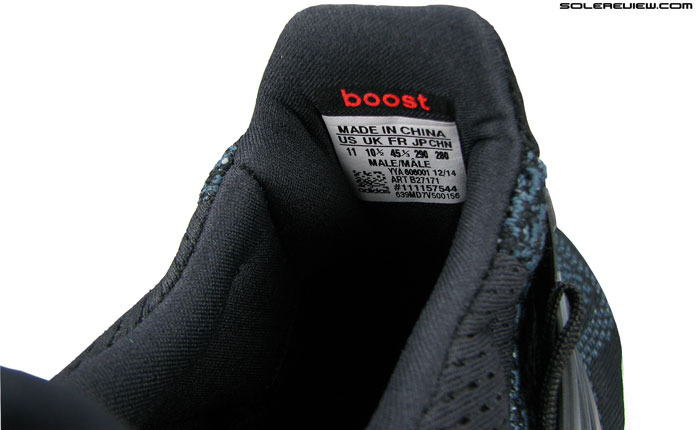
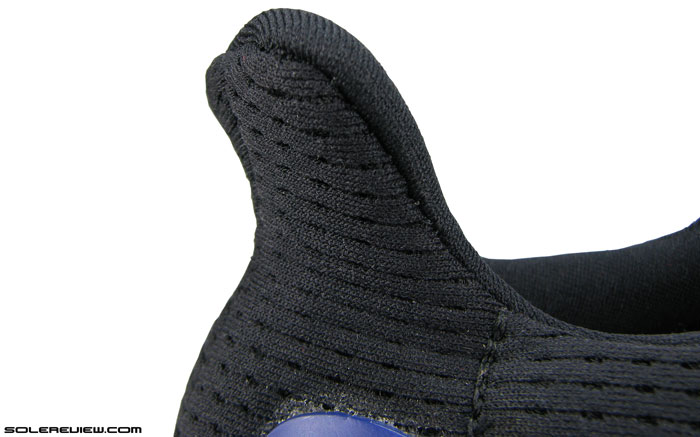
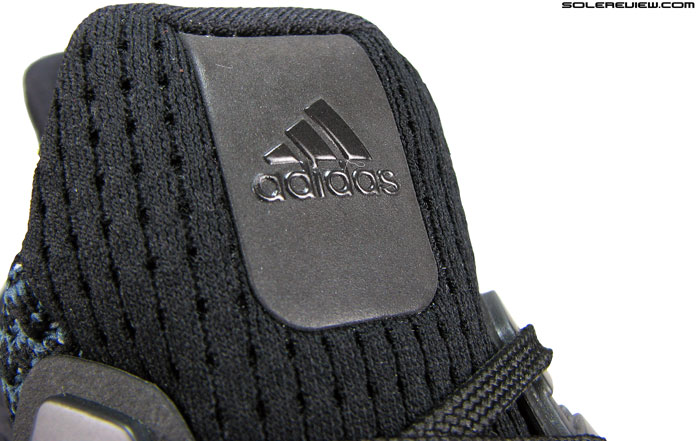
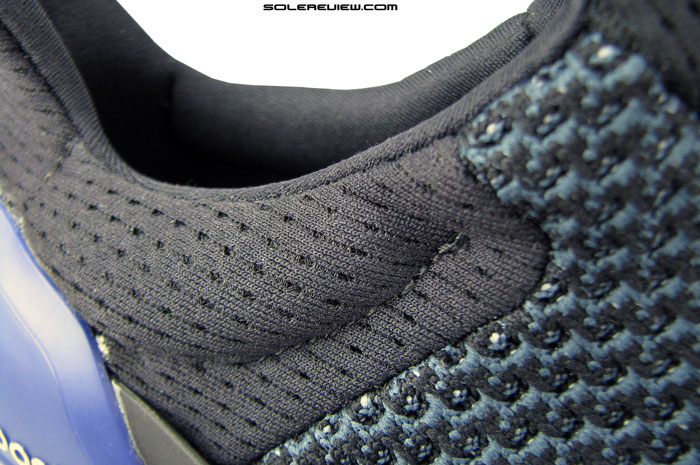
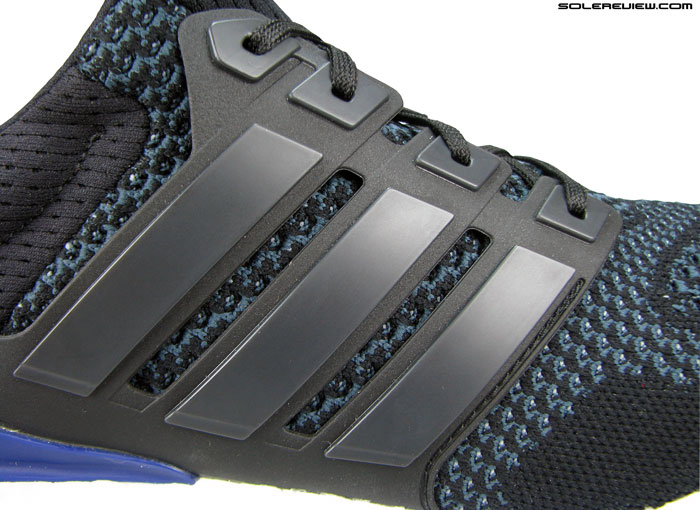
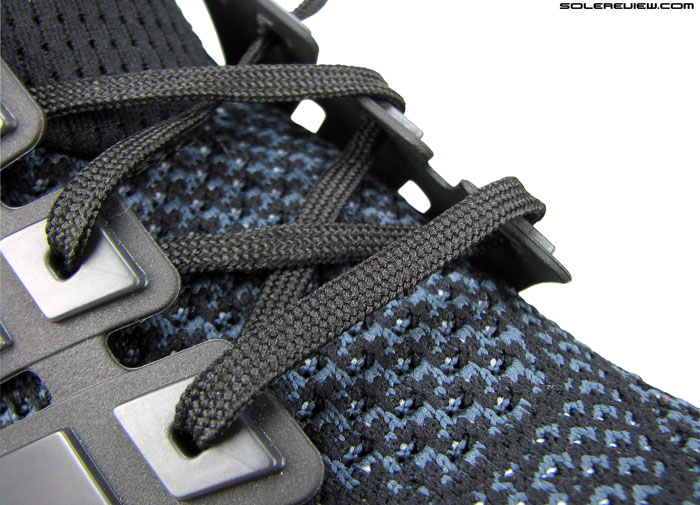
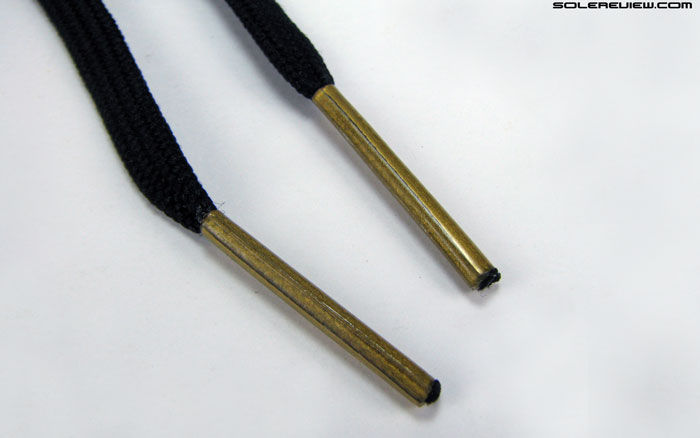
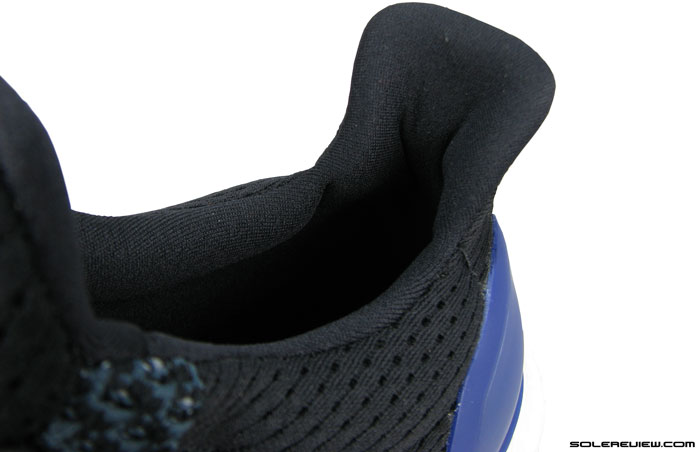
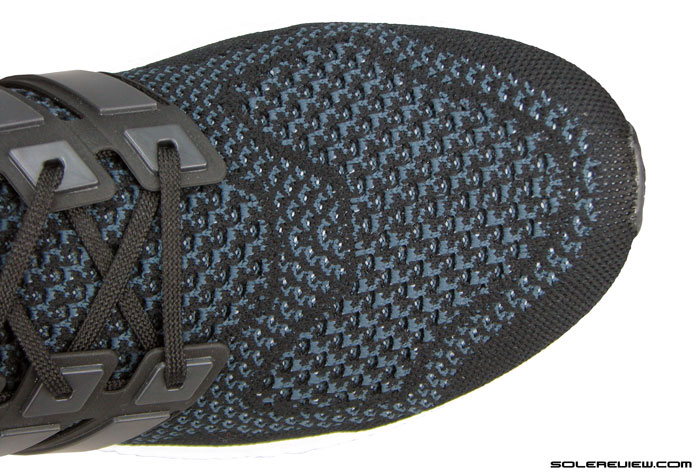
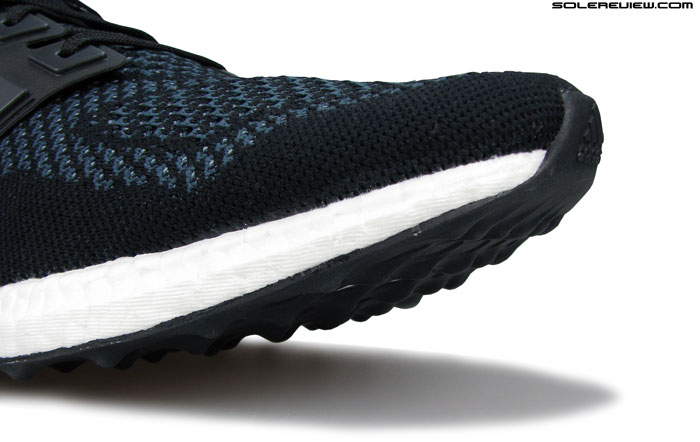
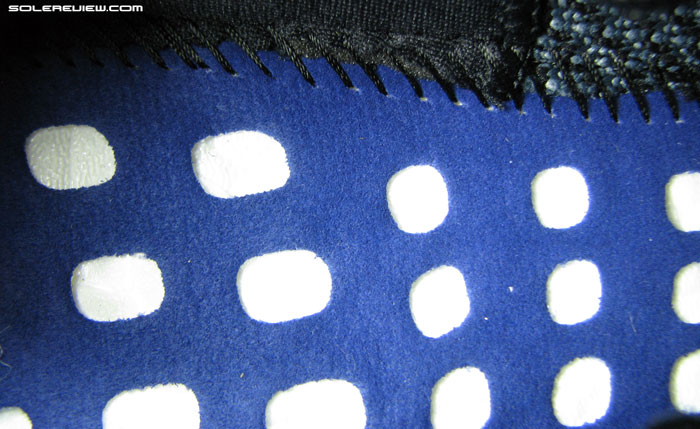
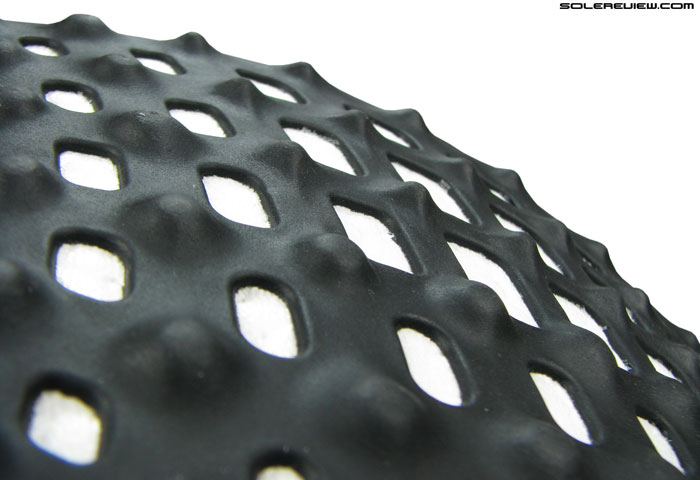
211 comments
Another great review.
What a shame the outsole has poor durability. I had read the same issue from people who bought this shoe so was expecting it.
Have you ever run in the Adistar Boost? If so how does it compare?
Thanks!
More than the fragile material used, the outsole was designed poorly.Why have a few lugs take the burden of a footstrike?
No experience on the Adistar Boost, so can’t say.
Wow, I’m glad I read this review before I make the purchase.
I was tempted to buy one of these when they first came out a month ago, as adidas advertised the shoe as its greatest runner ever. And I remember you rated the Energy Boost 2 a very high score of 91. I thought the Ultra would really be the greatest. Haha.
But after reading your review, especially on the outsole durability, I don’t think I would buy it, at least at this US$180 price mark. (and I am a mid to forefoot striker).
I did tried the Energy Boost 2 at the store, but the boost foam ends at the very tip of the forefoot area, which felt really awkward to me when I did the little walk test at store.
I’ve got a low arch but do not overpronate too much. I used to run in Asics Nimbus 14 and currently in Nike Lunarglide 6 (which is great). I am looking for a new shoe so I can switch between pairs. The outsole of the Lunarglide 6 still looks fine and maybe can hold up for few months. Do you think the Nike Lunar Flyknit 3 would fit me or should I wait for the Lunarglide 7?
We like the Ultra Boost over Energy, but c’mon, that much of outsole wear in so little time? Not happy.
Both the Lunarglide 7 and Flyknit Lunar 3 have the same midsole/outsole, which is carried over from last year. But the LG7 has a completely new upper, so would have to wait till July to find out what has changed from a fit angle. But as far as the durability is concerned, both LG6 and 7 will be exactly the same.
You can also try the Flyknit Lunar 3, it has got a durable outsole and a cushioned ride. That said, we did not quite like the hard heel counter on the Lunar 2, so waiting to test this year’s model to see if anything has changed. The review should be done by early May.
Another stellar review. This was definitely worth the wait.
The quick wear and tear of the outsole is such as good reason to ignore this shoe. It kinds of undone all the good things. I have an EB2 and sticking by it. Maybe time to stock up on them since there are huge discounts these days.
This review was a long time in the making, the writing began in mid March, actually.
Yes, what is the use of all that upper if there is no outsole to run on?
Thanks for another excellent review. I’ve been keeping close tabs on the Boost models as my main running shoe is the GB6 and I race with the AB2. I actually ran about 5 miles with them yesterday as part of an Adidas test run with a local shop and quite liked them. Having sensitive Achilles they have an ideal design in that respect as you point out and they felt a lot more comfortable than the EB2 and their compressive techfit. I normally wear US12 but they only had US11.5 and they were fine so unlike what Shoeftr shows I’d say they wear a bit larger than the GB6, AB2 and of course the BB5.I suspect the Primeknit is the cause of this as it stretches a lot more than the techfit or the more traditional upper of the GB6/AB2/BB5.
I’m a forefoot striker and I didn’t feel they had a lot of cushioning in spite of the additional Boot material they claim, maybe it’s not in the front? Or maybe it’s because there’s no EVA like on the other shoes that provides a “harder” but more “consistent” cushioning while remaining “soft” thanks to the presence of Boost.
The wear of the outsole you found is quite worrying after only 30 miles. I did check the sole yesterday and actually thought it was pretty strong since it didn’t show much wear although these test shoes had been used a few times before…for less than 30 miles apparently!
Can’t really see them replacing my GB6 for serious training, for some nice relaxed running, maybe, but then the Skechers Go Run Ride 2 are fine for that too and cost me 1/4th of the price!
We’ve always suspected that shoefitr only maps the static volume of a shoe upper without accounting for material stretch – don’t know for sure, but many similar comments on this forum evidently suggest that.
We did say the rearfoot and forefoot behave as two different halves – very cushioned vs minimal, so it is natural that you felt the way you did. There isn’t much Boost in the front!
Yes, the outsole is an issue – there is unanimous agreement from a lot of people when it comes to rubber durability, or rather the lack of it!
Thanks for pointing out the “different halves” part, I didn’t realize it would be that “bad” in the front. More a heel striker shoe then…well a heel striker who runs 10 miles a week ;-)
The cushioning is definitely more softer in the heel, and agree, the shoe isn’t meant for high mileage, given its delicate outsole.
Just curious as to why you scored the EB2 higher than the Ultra if you say you liked the Ultra better. Is it the outsole durability that caused the mark down even though you like the feel of the Ultra better? BTW, great review. As a running shoe nerd, I really enjoy visiting your site.
Actually the outsole durability part doesn’t carry much weight in our scoring system.
https://www.solereview.com/mizuno-wave-inspire-11-review/#comment-1800786881
To be entirely honest, our scoring system has evolved vastly since the EB-2 review last year. If we to review the EB-2 Boost again, perhaps it would score lesser than the Ultra.
Great review as always. I actually purchased and returned these because the toebox was way too shallow for me and my foot size prevented me from sizing up. After reading about the durability of the outsole I am glad I did. If I would have paid $180 and gotten less than 200 miles out of these I would have been highly pissed.
Thanks for the comment, Jinkazama. The toe box can be bothersome, depending on how you like your shoes. Personally, we’d have preferred something more roomy.
200 miles? Was reading a comment today about how these don’t even last for 70 miles. Of course, there are variables involved in a thing like this, but still…
Yeah, I saw that comment after I posted…70 miles for a $50 running shoe is unacceptable; for $180 is outrageous.
Hopefully adidas fast tracks the UB 2; it looks like they have a lot of unhappy customers so they need to get this rectified. I like boost tech and the more competition in the market place the better for the consumer, but they blew it on what could have a great shoe.
Maybe they will, maybe they will not. Depends on the retail return % for the Ultra Boost. If it hurts adidas financially, then they will make changes as needed.
I remember an old pair of soccer trainers I owned as a kid designed for hard, dry dirt fields..I’m 99% certain they were adidas…same pimpled, pointed nub type rubbery sole…and same ridiculously fast wear & tear on them.
I have watched several videos on the design and manufacture of these shoes on you tube and I can’t believe they have screwed up the outsole like this- in a behind the scenes type documentary one of the adidas guys mentions that they have a family living in a forest somewhere in Germany who test shoes for them as the family rack up over 1000km/per week between the whole family (!)…well it must be all on grass, soft trail…and adidas also have some contraption they put the shoes on and it simulates running around and around in a small circle…but it doesn’t seem to replicate the same effects of a human striking against a rough, hard surface at various angles and force.
Loads of negative feedback on the UK adidas website from unhappy customers too.
Fantastic review by the way :-)
Thank you for the comment!
Actually we’d give the soccer boot benefit of doubt :) Fixed rubber cleats are particularly helpful on hard, packed dirt. They grip well, and don’t jarr your knees.
Once you have some moisture on the field, then it’s the harder FG (Firm ground) cleats, and the six-cleated configurated SG (soft ground) boots for premier league matches on soft soil and grass. There are hard ground boots available now which use hard TPU, yet we’d prefer the rubber tips!
But the Ultra is a running shoe, and this rate of wear is unacceptable, regardless of all the marketing media they put out.
Glad to see a detailed review on this shoe, and in particular another opinion on the plastic ribcage shared by the Energy Boost. I had a pair, and the plastic cage was not a pleasing feature at all. The EBs got donated (a very expensive trial). Now I have a discounted pair of Glide Boost 6, which without the rigid cage is a more pleasant experience (couild use more breathability though).
Thanks again for the incredibly detailed reviews!
You’re welcome. Hope we can keep the reviews coming!
Not fond of the plastic cage either, but the one on Ultra feels better than the EB-2’s.
And as we mentioned in our review, the Glide is indeed the most balanced of all adidas Boost models.
Ive enjoyed the Glide and 2 as really great running product. I bought the Ultra with great anticipation. After one five mile run, premature outsole wear, poor support under foot, sloppy upper fit and for $180 its a joke. Not sure why the got away from Continental outsole compound , it wears like iron.Maybe the worst shoe intro of 2015 so far.
I bought the Ultra Boost and ran 210km in them. I didn’t actually mind the Sprintweb outsole. With the last Boost shoes I had, the Continental rubber wore down so much that the midsole was touching the ground, so those extra few mm’s on the protruding lugs of the Ultra Boost extend the outsole life because they have to wear down first.
Here in South Africa, the Ultra Boost comes with a 30 day money back guarantee if you don’t ‘feel the energy’. So I returned them mainly because of the price. They are 2500 Rand here which converts to about $210! Adidas’ marketing pitch of “The greatest running shoe ever” made me curious to give them a try. Yes, they are very good running shoes but are they worth the asking price? Definitely not.
Great to hear that you could return them. Outside of the United States and a handful of other countries, that option is not even available.
I decided not to post pictures I took at my local retailer, as this site deserves better than my inadequate illustration, but the reason I was taking pictures was that every single UB unit I picked up, both from the shelves and the POP display, had some sort of visible misalignment and one or more glue stain. The glue stains may be cosmetic issues, but one should not see that in a $180 shoe, much less gross flaws in assembly. I was frankly shocked.
Post them! Post them! Post them!
OK, these are just from my phone in the store, so really not up to the Solereview standard. But they’re from three different pairs I just picked up off the shelf and display. It’s not like I went looking for problems. I was really put off by this. It wasn’t a discount reseller or anything, not a “factory outlet”. This was a major retailer on Broadway in the Financial District of Manhattan, a “showcase” store.
kinda makes you wonder about the recent strike they had(or still having?? not that updated) in china (assuming some these and the tempo boost came from those areas)
A good theory, but it won’t affect the quality if processes and QC systems are in place. Also, brands spread their production across multiple factories, so they can move manufacturing if need be. The strike also happened recently, much after these shoes landed at retailer warehouses.
It looks as if these are just minor cosmetic defects which all the Ultra Boosts have. It won’t change the feel of the shoe when you’re using them?
I’m not an expert on the subject but have been buying running shoes for 38 years, and two things strike me: First, you don’t see this that often with other quality shoes. Solereview will often point out misalignments, but by way of saying they’re the exception, not the rule. Second, the misalignments affect wear. There were places on one shoe I picked up where the runner would absolutely be scraping one edge of a heel with the Boost foam. Naturally that’s going to wear unevenly. It’s more than cosmetic. It also represents a trend in the wrong direction. When you can see things that are amiss you have to wonder about those things you can’t see.
The misalignment is a functional defect.
Sad to read this- I still love adidas but sad to hear so many quality issues. I recently bought the Asics Gel Nimbus 17 and, although it is an entirely different type of running shoe, the build and manufacturing quality is simply superb.
By some stroke of luck, our pair turned out to be remarkably (and surprisingly) well put together.
Tried a pair and sent them back after about a 5-6 mile run. I do like the stretch upper and that is about it. The Boost material doesn’t work for me, not sure why but it doesn’t. When I got to about mile 6 the PF in my left foot was hurting so bad I couldn’t continue. I have since tried the NB Zante and the Borocay. Both of these shoes have helped with my PF issues and the Borocay may have ended my search for my (and I stress my) perfect running shoe. I have done a 1/2 and a 15 mile run in the Borocay with no issues and my legs felt fantastic after both runs.
Just my 2 cents. Thanks for the GREAT reviews on this site.
Thanks for the feedback.
Generally speaking, very flexible/soft shoes aren’t great for PF, and the Ultra’s midsole is super flexible right upto the midfoot point. Not ideal for your condition.
Thanks very much for all your reviews. I’m new’ish to this site, and I’ve enjoyed reading your reviews more than any other online resource. I’ve run on the Boost material for a while and enjoyed how it feels, but I’m learning the hard way that it isn’t the best choice for PF, as you’ve mentioned here. In fact, I’ve developed it while wearing the Boost sole over the last year. So while I was interested in your Ultra Boost review, I’m not surprised to learn that it’s not the best shoe for me to consider next. On that note, I was hoping that you might have a thought or two that would point me in a better direction. I’ve read many of your reviews, and even tried running for a week in your top rated Saucony, but I found the fit to be a bit off for me and I’m torn about what direction to go in next. I’m an over-pronator, but have found over the years that trying too hard to correct that often leads to knee pain (NB roll bar technology was what I used for years), so I’ve leaned toward a neutral shoe in recent years, assuming that there was no harm in over-pronating a bit if that’s how I’m built. But I’m struggling to find the right arch support and relieve the discomfort of PF, while still running in something lightweight and responsive. Should I be reconsidering motion control or stability shoes? Are there any particular shoes on the market that those of us with PF should be paying close attention to? And, to complicate matters, I’m prone to shin splints and struggling with them now, and I don’t know if that should also have an impact on what choose I run in. Thanks very much for any thoughts you might have.
Your story seems really similar to mine – I had always used a moderate motion control shoe and the UB felt great in the store but on the road it flared up shin splints and PF with me (and was wearing out way too fast). After a trip back to the shops I ended up in a pair of Mizuno Inspire 11 which for me solved my problems almost immediately. i just went to the list of reviews on this site and sorted it by rating and then made a note of every motion control shoe with a good review and tried them all on until i liked one the most.I ran a “bracket tournament” with different shoes on each foot eliminating losers until i was wearing the same shoes on both feet! good luck finding a shoe that is right for you.
Thanks for your thoughts, Spence. I have decided to go back to a moderate stability shoe and see how that works for me. For a while now, I’ve enjoyed the feeling of running in a neutral shoe, but I have a fair amount of evidence that my joints and feet do not, and I’m going to explore my stability options again. Based on the reviews on this site, and trying several different models of shoe in the store this weekend, I think I’m going to give the Supernova Sequence Boost 7 a try and see what happens. I like your idea of a “bracket tournament” – that’s brilliant – but I don’t have the budget to put that many shoes to the test. Perhaps I’ll be in a position to find the perfect shoe that way someday. I’ll keep it in mind…
The bracket tournament happens in the shoe store!! I thought the salesperson was going to kick me out towards the end as I tried on like 10 pairs of shoes!
I just saw this – that’s awesome. I never thought about conducting the entire competition in-store. You probably had them muttering obscenities in the stock room, but it’s still brilliant. I’m on week two in the Supernova Sequence Boost 7, but not quite ready to render a verdict since I have an unrelated minor injury keeping my miles way down right now. We shall see.
Sorry for the delayed response, this one went way past our 4 day reply window!
Correct, the Ultra Boost is not the right choice for runners with PF injuries. Generally speaking, shoes which bend in the forefoot while keeping rest of the midsole rigid is compatible with a PF condition. The Ultra Boost is not of this category, as flexing extends upto the midfoot area.
So before you try/buy any shoe, just try the ‘flex test’ first.
Not sure which Boost shoes you’ve been wearing, but not all Boost models behave the same. Shoes like the Supernova Glide Boost (Neutral) and Sequence 7 Boost (stability) are great shoes which combine cushioning and stability. We read in your later comment (below) that you are going to give the Sequence a try, so would love to hear how it goes for you.
Minor soreness/splints are also alleviated by incorporating conditioning/strengthening exercises, so the shoe alone might not be the solution for everything :)
I’m on my third pair – they never get past 70 miles before returning them as the outsole is down to nothing. They are ideal for my marathon in London on 26th April so will get another pair before the day. I absolutely love them other than the outsole. It’s like I am renting them as they keep getting returned. I did a review on the adidas website but when I tried to follow this up find I been banned from posting! Nothing abusive or even that nasty or critical but they just don’t want anything else negative. They have made a major error here possibly to save a few grams of weight – But clearly not properly tested, a bit like apple when they release a new product with the sim card in the wrong end l – I complained in writing to adidas they eventually gave me 30% voiucher but wont let me use it to buy another pair of Ultra Boosts. Presumably there are going to be a few people clearing their desks pretty soon.
70 miles ? That’s bad ! What state are they in by that point ? Lugs worn out or worse ? What’s amazing that they keep letting you return them, via their website or in a store ?
Here is a photo of a brand new one next to that of another which has done 70 miles hope you can zoom in – adidas refunded me £30 today!
Thanks, there is some wear indeed but it doens’t seem “destroyed”, so the shop are acknowleding that it’s not normal and that the shoe is not usable anymore ?
Still looks OK to me.
It’s strange that 30 miles did what they did (review picture) and your shoes after 70 miles looks really fine to me. Do you run indoor?? Because the wearing is completely different from the one explained in the review
The high price includes already several returns. :)
If 30-35 miles did the pictured (in our review) level of outsole wear, we can imagine what 70 miles must have done on your pair. Thank you for sharing the comparative picture in your reply below!
adidas banning negative reviews and posters? Now that is a new low.
do you think with the number of reviews all complaining about the outsole durability, that future releases would fix this HUGE issue??
looking at some adidas shop sites, this looks like a huge and major concern…
I doubt this issue happened unintentional, not sure if there’s something to fix from Adidas’ perspective.
Exactly.
You’d be surprised to know how little time brands spend on proper, long term wear-testing when it comes to most shoes.
Thanks for this great and revealing review! In my country (Uruguay), Adidas is currently offering a stride test in their stores, I will go to check this shoes, just to check by myself how do their work, but after the comments and the review is very unlikely that I will bought them! here a pair of UB should probably cost more than U$S 200…
You’re welcome. Glad to see you found our review useful.
The outsole wears off pretty quickly, so unless there is a return/exchange policy in place, not worth spending the $200!
after seeing the earlier marketing video about the UB, I was curious and sceptical at the same time. but after seeing the msrp, I just can’t find the justification to even consider buying a pair.
and now after reading your review, the UB’s outsole durability issue is really making the price even more unjustifiable. to me, that’s a rookie mistake. one I didn’t expect from a big brand like adidas.
Unless there is a return policy to cover you, $180 is a lot of money for a shoe which wears down that fast.
Thank you for this great review! I bought a pair of UBs last weekend and after a couple runs (on clay) i noticed some wear on the lugs. I got anxious about it, i mean, it shouldn’t happen that fast. At this point and after reading your outstanding review, i like the ride and overall feel of the UB. On the other hand, my concern about the outsole wear is greater than i expected. I’ll find the way to return them in case this gets to be a major issue (which i believe it’ll).
The ride’s pretty good and so is the fit – but good idea to box it back to adidas in case you see the nubs wear off quickly.
Some reader was mentioning that the Ultra Boost becomes very slippery in wet, and that should become more so after the outsole is flattened.
No doubt… Just yesterday i almost fall on a wet pavement. It felt just like being on Converses’. Also, i’m flirting with the idea of going barefoot in the UB’s but i don’t know, what would you say? Thanks again!
The only issue with going barefoot is that the internal toe bumper might catch on your small toe. More details in our review, with pictures.
Well… i tried them sockless for my insanity session yesterday and everything went ok (a little lose overall though my foot is kinda slim). Today i’ll go to the track and see what happens.
Great to hear that.
By the way, did you send us an email through our contact form? If so, can you please send it again? (our mail server’s acting a bit funny) Please ignore if it wasn’t you.
Actually I did, but i’ll send it again… ;)
Hello! Have you got my email, yet? Thanks!
Yes, thanks! We will reply soon.
Your test is superb, thanks, Solereview. I would suggest Adidas Ultra
Boost designers to tell Continental to manufacture a rubber for the sole
sneaker thinking in runners themselves and people, not in following Adidas´ greedy
instructions blindly. I am using a pair of Ultra Boost USA size 12 and the sole is made of butter rather than rubber. I heartly recommend Adidas a renaming for their “”BEST RUNNING SHOES IN THE WORLD”: Ultra Greedy Booster (U.S. slang: shoplifter)
Thanks for the review. You saved me some time and money. :)
Those aficionados to Formula 1 know soft rubber tires perfectly. These cars use Ultra Soft Tires intended to last just one lap, classification, a second lap, if you fail to classify the first time, useless. When Japanese Tire manufacturer Bridgestone decided not to provide their rubber tires to Formula 1 cars it was the Italian Tire manufacturer Pirelli the people who introduced so soft rubber tires intended on purpose to change tires several times during the race to add something new to the racing spectacle that in some races they exploded putting in danger the drivers. Now those explosive rubber tires do not explode any more but they are designed to last not as many laps as the hard rubber tires drivers are forced to use in some moments of the competition. German Adidas has told German Tire manufacturer Continental AG to manufacture a rubber sole for the ‘greatest running shoe ever’ (Ultra Boost) to last a few kilometers in a perfect condition, althoug they could have produced a much harder one with the same good qualities. The problem is that greedy Adidas wanted runners to buy a pair of the ‘greatest running shoe ever’ with a certain regularity. In the past incandescent bulbs were designed to work for a calculated period of time and then die, we are happy today with cheap LED ones. I don´t certainly like the new Adidas material used for soles: “Rubbutter” (rubber and butter). But it is not only Adidas Ultra Greedy Booster (U.S. slang: “shoplifter”) who are pulling on our legs thinking we are so fool not see greed. I suggest truly independent and
excellent SOLEREVIEW to study and test Rubber or any new Compound in the future even more carefully if possible.
Butter rubber – that’s a nice way to put it!
what are some alternative to the ultra boost that would be similar as in soft cushioning and flexible?
While being very different, the Fresh Foam Zante and Nike Lunar Launch are alternatives to consider.
If there’s one thing to watch out, it will be the 4mm heel to toe drop (difference between heel and forefoot thickness) for the Zante/Launch compared to Ultra Boost’s 10 mm. This can put pressure on your Achilles and connected systems.
Thank you.
REMARK and CLARIFICATION:
Formula One, or F1, proper name for the word “classification” is “Qualifying”: Q1; Q2 and finally Q3 for the remaining 10 best cars and drivers. They can use 6 types of rubber Tires: Super Soft is Red color; Soft is Yellow color; Medium is White color; Hard is Orange color; Intermediate is Green color (Wet, no standing water) and the last one is Wet, Blue color (Wet, standing water). The first 4 colors are slick tires and the last 2 are tread.
@solereview:disqus – in the spirit of “what ifs” (similar to the tempo 7 boost)… if the outsole didnt wear as fast as they do (think supernova glide boost ish)…. how would you grade it?
It won’t be very different – outsole durability does not carry as much weightage as stability, quality of transition and upper fit.
Maybe the Stella McCartney edition is more durable. ;) Already in stores with a hefty price increase just for another color scheme. Seems like Adidas will release more of those from different “designers” in the coming weeks.
Thanks for a great review, as usual!
I am 33, 177cm tall and 72kg heavy. I am training for my first Half marathon and planning to train for full in the next year or so. I am currently using the Hoka One One Clifton for distance training and the NB 1500v1 for speed training and love them both. My questions are: Would you recommend the Ultra Boost as racing shoes for HM+ races or should I stick with the 1500v1 (or others?) for races? And, if I want to introduce Trail running as part of my training, which shoes would you recommend? Thank you so much!
Would suggest to stick to the 1500 v1 if you’re happy with them. It has enough cushioning to go HM and under good pace.
We currently don’t review trail footwear, and can’t recommend a shoe. But websites such as the runblogger, gingerunner (ytube) and irunfar feature trail shoe reviews. Maybe a good idea to visit those resources and see what you can find.
Any thoughts with regards to a review of the Climachill Cosmic Boost? :)
Considered it, but not sure yet. If we do review, won’t be till before June/July.
Hi – I just completed my first marathon (London), but consider myself a bit of a running novice, and have no idea when it comes to shoes. I did the marathon in the old pair of asics I had kicking about which I bought without really knowing what I was doing.
I’m now trying to get a bit more serious and can’t make up my mind: should I get two pairs (or more?!) of runners? One light pair for speedwork, a heavier, more cushioned pair for weekend long-runs? That seems to be the consensus I’m picking up from the comments around the site…
Any help appreciated!
For a start, how about getting a shoe which has a bit of both? This middle ground will give you a good idea of how ‘light’ do you want to go, and what level of additional cushioning you crave, if at all.
Fit try the adidas Supernova Glide 7 Boost, UA Speedform Gemini and the Saucony Breakthru and see how they feel.
And if you get a chance, fit test the New Balance Fresh Foam Zante too. A bit towards the lightweight side, but is still packed with plenty of cushioning.
If you insist on splitting the two, then consider the adidas adios/Boston Boost and NB 1500 V1 (never mind the medial post) for speed, and then the Glide 6 Boost/Pegasus 31 for long and slow.
Having trouble finding a Glide 6 Boost – any reason I shouldn’t look at the 7?
Nope. The 7 is a good one too. Same outsole/midsole, slightly different fit. Here’s our review and comparison:
https://www.solereview.com/adidas-supernova-glide-7-boost-review/
Ah yes, sorry, just saw you’d actually recommended that as an ‘all-rounder’ in your first comment.
Well, I’ve ordered four pairs to try at home (a 365 day return policy, but not as good as the US shop that lets you try them outside for 3 months!) and I’ll come back and let y’all know the winners.
Thanks for all your help.
Would you recommend the Kayanos or the ultra boost?
You need to be more specific. Like what you’re looking for in a running shoe.
Hi! I’ve read several of your reviews, your job is awesome! Congrats!
I’m wondering about buying a running shoe.
I’m more or less 85kg and have wide feet (neutral-pro forefoot runner).
What I’m looking for, is polyvalent and versatile shoe (kind a all around)
Running (5-10km and sprint), but also sports like fitness, or some recreational sports.
I can run from 0 to 2-3 times a week, it depends on the period, but I’ll use it also for some sport and when I’ll walk a lot.
I’m also looking for a shoe which is very comfortable, flexible, responsive, with good transition and and ventilation and beautiful (yes, a shoe that I can wear with a jean).
(I’ve already had a sprained ankle if it could help).
The first pair I wanted to buy was the adidas ultra boost, but the durability of the outsole you mentionned makes me hesitate… There are also the flyknit 4.0, the pegasus 31 and the new balance 1500 v1.
Which one one these would you advice me for my use?
I’m open to others shoes.
Thank you!
Between the three, we’d recommend the Nike Pegasus 31. Also try the New Balance Zante, the adidas Glide Boost and UnderArmour Speedform Gemini and see how they feel.
Thank you for the quick answer!! I’ll try the pegasus
So, you think the ultra boost would not be a good deal ?
A $180 shoe which wears out that fast? Didn’t want you to have a bad deal. They also slip a lot on wet surfaces.
In fact I can have them for 120€, that’s why I’m hesitating.
Still you’re right.
And just a last question, what’s the most comfortable between the shoes we’ve mentionned ?
The Ultra Boost is. Within the other list, it is the Pegasus 31.
Thanks for all your fast answers, I’ll probably go for the Pegasus!
Continue with your great job! ;)
Sorry to disturb you again… But do you think the new Nike Vomero 10 would be a good choice for my use?
Yes, that one too.
Alright! Thanks! :)
Do these shoes have micoach’ foot-pod cavity?
No, these do not.
Thank you and do you know just the energy has the footpod cavity?
Yes, please read our Energy Boost review for pictures of the pod.
https://www.solereview.com/adidas-energy-boost-2-review/
Great review! Very complete and detailled! Good job guys, as always!
I was wondering, the outsole wears initially very quickly, but you said the wearing rate decreases, so it shouldn’t be really a problem in the long term, isn’t it ?
Still, once the snubs completely wear off and the outsole became flat; what consequences could they be? (Except the slip on wet ground).
Thus, if the UB priced was around 100-130$, would it be worth ??
Thanks!
If you’re running only on dry roads, then should be ok for 200 miles or so. And yes, $100-130 would have made the Ultra much value for money.
Yeah I do not ride on wet roads..
So, the “becoming flat” issue, wouldn’t be a real problem according to you?
And what do you think about the comparison image someone put between the new pair of UB and the one after 70 miles, don’t they seem ok?
Won’t be an issue as long as you stick to dry and clean asphalt. The durability should not be an issue for at least 200 miles. The wear is excessive compared to regular outsoles, hence the reduced mileage forecast.
Thanks for your availability! :)
previously i had adidas energy boost 2, size was UK 8(US9) ,it was tight for me,as it was techfit technology,this time i am buying adidas ultra boost ,,what size will fit me ,i read thE ultra boost shoes REVIEW is not techfit ,,my regular shoe size is UK8 (US9)please suggest me what size should i buy,, and also suggest me that adidas ultra boost is better than adidas energy boost 2.i fell great when i wear energy boost shoes ,,is ultra boost as same foam density as energy boost ,,please suggest me can i o for ultra boost or stick to my energy boost ,,or shall wait for another adidas technology to come ,,,,i jog for 30 minutes and walk for 30 minutes daily
Please re-post the comment after grammar corrections, spellcheck and line breaks. Your question is hard to read and understand.
Hi! Are these as soft as the Nimbus 17? Ive heard Boosts become abit tricky on wet surface, is that so?
No, the Nimbus 17 is softer. And correct, the Ultra Boost gets slippery on wet surfaces. The other Boost models (Glide, Boston, Energy) grip well and last longer.
I just bought a pair of these. I’ve also noticed that the nubs are already worn down in some of the heel area already after my first run. I agree its not acceptable, but do any of you have any problem with the whole sole being worn down fast or just the nubs? I dont intend to use them in wet condition and doubt that – even though the soles a worn down a bit – it with effect the grip that much in dry conditions?
However, I do have a few other issues with the shoe. Its been years since I’ve had any knee problems. First run in these and my knee start to hurt. Kinda strange with all that shock absorbtion, but maybe its because geometry of the shoe makes you heel strike more than usually. Even my calves were more tired. I wonder if all that boost is not only nice and soft, but also makes your legs works that more (almost like running in soft sand). Last thing – never understood that people think flyknit, primeknit and those types of material is more breathable. I always sweat so much more when having this type of semi-thick woven material close to my feet.
The rate of wear will slow down once the nubs in high impact zones are shredded down to their base. The rubber sheet will take a lot more abuse – we think the Ultra outsole will give out at 300 miles.
Knee pain could also be due to the relatively unstable ride of the Ultra. A lot of cushioning could often translate into extra work for the musco-skeletal system trying to compensate for the roll.
the white/green… put some violet laces in…… joker esque O_o
nice find
Hi, Great review as always! Would you reccommend these shoes for a forefoot striker, as an everyday running shoe and also for walking around? Thanks in advance!
Thanks! Yes, recommend these for all the uses described. The sole is rather slippery, so use on damp/smooth surfaces should be avoided.
I started developing calf issues while wearing these shoes but I can’t really tell if it was because I was going too hard too soon or if the shoes were the culprit. First I had a small tear on my left gastroc while going uphill. After several weeks of recovery I went back to the track and my right calf started tightening. After the left calf experience, I try to stop and walk the remainder of my work out before “popping” the calf. I am training for an ironman and was wondering if there is another shoe you could recommend to help alleviate stress on calves while I recover. I am also a neutral, forefoot striker. Thanks and great reviews!
It would seem that a firmer heel with a similar heel-to-toe offset could help in your situation, but strongly recommend that you see a physio for recovery and footwear (type, not brand) advice.
Uggh, I love the way the boost type Adidas shoe’s cushioning feels, but they’re all just too narrow for my feet with torturous toe-boxes. When will Adidas get a clue an make shoes wider?
The worst part is, they don’t even offer widths.
Hi, I’m looking for shoes that are very comfortable for walking a fair distance, standing and just a bit of running. My feet are relatively narrow and roles outside when I walk. I’m considering Brooks Glycerin 13, Nike Air Zoom Vomero 10, Adidas Ultra Boost or Mizuno Wave Rider. Which would you recommend? or do you have other suggestions? Thanks
Hello Roxie,
The Ultra Boost is a good option, and also try the adidas Energy Boost 2 as well.
Really interested in this shoe, but the outsole durability really worries me for such a high price. How has the outsole been after the nubs have worn down?
The outsole becomes very slippery in wet once the nubs go down, and the wear gradually continues. Durability is low on the UB.
Hi, outsole durability problem solved in UB 2016 models. Now it comes with Continental with flat buttons. Perhaps they too read Solereview :) Here is the link for this upgradation.
http://www.adidas.com/us/ultra-boost-shoes/AQ4006.html
Thanks Sujit!
hi
the sizing is ok? So i don’t have to go half size down or up?
thanks
Hello Nick, we wouldn’t upsize, but really, it all depends from person to person. No substitute for trying them on yourself and see what feels best.
Deciding between this shoe and the Brooks glycerin 13. My feet do not really pronate, but I have very bad knees, occasional shin splints, and high arches (usually put an insole in my sneakers). I play basketball and I’m looking for a running sneaker to wear during training–mostly do short distance running and sprints. Let me know what shoe you think would be best, thanks!
Between these two, it should be the Brooks Glycerin 13. More supportive than the Ultra Boost, and the upper is more supportive too.
Thanks! Do you possibly have any other sneaker suggestions that could be good for some of my issues?
You should wear the Glide 7 Boost and see what you think of them. Well rounded shoe, nice cushioning+support.
Good day! How could I possible remove the the yellow my shoes have as seen on the picture? Thanks!
Is that dirt, or foam discoloration? Use Krud Kutter if dirt, and plain Vinegar if foam color issue.
Its a stain from the bleach I used to clean the shoe. I read an article that says, I can use hydrogen peroxide. Would you advise that as well?
No, don’t! Hydrogen Peroxide might react with Polyurethane based materials, which the Boost is.
What was the bleach made of, and what was the primary chemical’s volume by volume %?
did you ever end up getting that stain out? Looking for something to clean the Boost material as well..
Hi! My shoes usually stabilty shoes. I have Newton/Kayano 20 which is stabilty shoes. Is it ok that I will buy the UB even though IM a stability foot. Thanks.
Depends on what you’re comfortable with. The Ultra Boost’s ride is geared more towards soft cushioning rather than supportive ride. Try them on at the store and see how they feel – else you can buy something like the adidas Glide 7 Boost.
Thanks! I already try the UB on the store..you are right its comfortable while walking..don’t know in run. Another concern is the sizing..I usually have 8 size on my Running shoes, but in Adidas UB the 7.5 is fine with me. :-) Do you think I still Go for the size 8? Because I run almost 50KM in my ultramarathon event and Full Marathon every other month, thanks.
It’s your sizing preference, so go with what feels right. If you were used to a certain amount of space ahead of your toes on the Newton/Kayano, then use the same sizing benchmark on the Ultra.
I loved these shoes for about the first 50 miles. The soles started to wear out and I developed shin splints. Last pair of Adidas I will ever buy.
The sole of that shoe is its Achilles heel, pun intended.
I am currently wearing the Energy Boost 2. Very happy with them. My only complaint is severe Achilles tendinitis. I developed it before I purchased the shoe. So not blaming the shoe. But wondering if there is anything with the new Ultra Boost that might benefit me in this area. I am needing a second pair of shoes to train in and perhaps run my marathon in. Should I give them a try or stick with my EB2? I am wondering if the slight change in the sole might help the tendinitis or not. your thoughts. The main concern is price. Ouch!
I am also concerned about the softer sole holding up as well as the EB2. Is this a concern. Hate to pay 180.00 for a pair of UB if they will wear out sooner than the 160.00 EB2.
Since injuries have different causes – and generally not so much a consequence of footwear – we can’t offer an opinion. It is best that you consult a physio or equivalent.
The Ultra Boost is not necessarily a better shoe than the EB, just different in construction and cushioning feel. It also lasts a lot lesser than the EB, because the Ultra’s sole is very quick wearing.
In our opinion, the adidas Supernova Glide 7 Boost is a good shoe to rotate alongside the EB. A little firmer, but has a well spread cushioning behavior.
Well I purchased the UB Wednesday. I ran 3 miles in them and was surprised that i had virtually no Achilles pain that night or last night. I usually have pain all day every day. I ran 10 miles in them today and had no Achilles pain. Yeah ! I did experience some knee pain that I don’t normally have but I am hoping it was just a fluke.
I like the way they fit like a slipper. They fill snug but not tight with the material they are made our of.
Bummer that it may not last as long as the EB. I think I am going to really like the shoe. I can only hope that it will come down in price. I hated paying 160.00 for the EB. I really hated paying 180.00. Not sure I can get myself to pay that every time. :(
I have tried the Supernova Glide. It was good. I may have kept it but I was also trying out the HOKA at the same time so the HOKA won out on that comparison. I may give it a try again sometime as a second training shoe.
Thanks for the feedback! Which Hoka did you buy?
I purchased two pairs. The Hoka Kailua Trail and the Clifton. I liked them both but I started developing blisters on the inside ball off my foot. It is almost like the shoe curves up just tad on each side. So I don’t know if my foot is just too wide for that shoe or what. Oh well, I am happy with the Ultra boost. :)
Glad to hear the Ultra’s working well! Are you in the United States? Because there’s plenty of discount going around online for the UB’s right now.
And Hoka’s run very narrow by default, so nothing to do with your foot specifically :)
Hi, i want to ask if the knit material will get scuff and become fuzzy as time go on? The upper seems to look like yarn, i know it is not but will it get fuzzy and loose after some time?
We don’t have long term ownership experience with the Ultra Boost yet, so can’t say for sure. But haven’t heard of any negative issues from other runners so far.
great article btw – doesn’t get more thorough than that. I had a pair of energy boosts and love them but the toe box caused issues on runs longer than 20 km. Went to Asics Gel Noosa 10 but found these too rigid and hard on the forefoot. Back to adidas with the ultra boost and no regrets!
Thanks for the feedback! We’ve heard that the new Ultra Boost has a revised Continental rubber outsole, which should address the durability issues.
The toebox is so shallow my big toe is visible pushing against the primeknit!
Yup, in our sensory scorecard, we’ve moved the slider all the way to the left! Don’t do that very often.
What kind of shoe should I be wearing if the outside heel area of my shoes always wear down rapidly, right down to the midsole? Surely a stability shoe with arch support will push my foot to the outside even more? Is there a shoe that will roll my foot inwards? If a super soft like the Ultra Boost won’t do it, what will?
In this case, the initial foot strike area and subsequent loading of the foot has to be seen as two different things. In short, a stability or neutral shoe is no foolproof way to shift or spread the footstrike area.
Footstike is influenced by things like (or a combination thereof) running form, heel drop, outsole design and the surface (gradients, for example).
The easiest way here would be to buy something more durable, like adidas models using adiwear or Continental rubber. The Ultra Boost rubber shreds like refrigerated butter.
Hello Hansen,
Instead of the Ultra Boost, look at the adios 2 Boost and Boston Boost! Those are much better for going fast.
I was pleased with the Ultraboost, though the outsole wears down pretty fast, so, with winter in mind, i bought the Energyboost ATR. Unfortunatly, I didn’t care enough about your review of that shoe and ended up having problems with the cage – a problem that was mostly solved with the Ultra. The right foot is all right, but in order not to have the heel of my left foot moving up and down, I must tie the shoe to a point where the cage bites my feet. As you pointed out, this is not a good design. The contrast when I put on the Saucony Ride 7 gtx, I lace them and I’m ready to go, while it takes me 20 minutes to find a compromise far from perfect with the left shoe of my Energy.
I bought four models of the boost line (the Adios, the Boston, the Ultra and the Energy), but now I’m gonna switch to Saucony. Yes, the anger I had with the Energy is for something in that décision (I almost gave then away to a beggar), but the main factor is the price. Adidas is charging way too much for a pair of shoes.
Thank you for the detailed feedback, Louis.
Funny that for a company which practically invented sports shoes, they make some strange design decisions.
In all justice to Adidas, the Energy Boost ATR seem to strech and become more confortable after 20, 30 miles. You have to break those shoes in.
Thanks for the feedback! We haven’t tried the ATR, so this is useful.
I am looking forward to trying the new incarnation with continental outsole next week.
I have found the EB’s more responsive than the UB’s which is strange as there is less boost foam, anyone else found this?
We found the EB to run softer/more cushioned than the Ultra (called out in the review too) – is that what you meant?
I really liked the EB 1 and find them faster and more responsive than the UBs although for a long run or marathon UBs are fab. I also have Achilles issues so the design of UBs is brilliant and anything ełse can cause irritation
Are there any other shoes you know that have a similar heel counter to the UB’s as so many curve in
Sorry, no idea. Most shoes have curved-in heel counters.
Thought you might be interested to know that today I picked up a pair of Ultra Boost 2.0 – The big change is the outsole which is a massive improvement and is made by Continental as was the case on the first Energy Boost. The layout of the studs/pimples is flat and they are moulded on the medial side to give more support. The upper feels a little less plush but has closer knit as the fabric gets closer to the boost foam which is designed to stretch less and give more support here too. – The weight according to my scales is 358 grams for a UK 10.5 US 11 which is over an ounce gain in weight from UB1, this is probably the reason they put on such sub standard rubber in the first edition – I have sent these UB1’s to adidas for their comments on the excessive wear on the sole. Having now run a whole 3 and a half miles in the UB2’s they may run slightly smaller or truer to size than UB1 and am considering going back for a size UK 10. Will see how it goes as have 30 day trial.
I don’t think it’s called Ultra Boost 2.0 ;) but the new color codes like AQ4005 have indeed a new Continental rubber sole design. The size feels exactly the same to me.
Interesting, thanks for the feedback. We’ll try to buy a pair soon.
The answer as to whether Ultra Boost was actually an Energy Boost 3 is no as have been sent this link http://www.adidas.co.uk/energy-boost-3-shoes/AF4917.html
Thanks for the link. Will try to buy one for our review as soon as we can.
AQ4005:
Thanks!
Any plans on reviewing the Ultra Boost ST?
Can’t say yet.
Is it true the Adistar Boost will be replaced by the Ultra Boost ST?
I’ve been running on the Adistar boost ever since it came out, and I haven’t likes any other model just as much. Would be too bad if Adidas completely discontinues the Adistar boost.
* Loving your website btw! Thanks heaps for all the hours of hard work and dedication you put in it..!
Yes, that is what we’ve heard too – that the ST is the Adistar’s replacement.
Thank you for the comment!
Oh! I would love that! I’ve been hoarding the Adistar boost like a crazy woman, but eventually I will have to say goodbye to the beloved Adistar with it’s amazing crashpad.. I’m contemplating switching to the glide boost / sequence boost / hoka’s after my next marathon – but maybe the ultra boost is a viable option. :)
(Any advice on switching back from the soft pillow-like Adistat? I’m a severe overpronator with a love for max cushioning but weak ankles.. Run on the Saucony Ride 2 before switching to the Adistar, which are way bouncier and softer)
It would appear that adidas is letting go of the formotion crash pad entirely, so expect upcoming shoes to feel completely different.
Will you like them? Not sure, and we’ll know more once we get our feet inside the Ultra Boost ST.
I would like to share my experience with the new, updated Ultra Boost.
1. The outsole has only marginally been improved. It still wears down much faster than any of the other shoes in the Boost range. I think it has something to do with having less ground contact than the other shoes.
2. The prime knit upper remains the same as version 1 except for one very strange tweak: the midsole cage has been extended by the first eyelet. This modification makes the plastic cage dig into the knitted upper and ruins it, making it look all scruffy.
My view is that it is definitely not worth reviewing such an expensive shoe for so few changes. Review the Ultra Boost ST instead ;)
Hey thanks, Brandon for the quick review! Very helpful.
Agree, not worth reviewing the 2016 Ultra Boost – seems the same as last year.
Is it the “continental” sole?
Thx!
Yes.
Really? i heard only good things about the “new one” hmm… not sure if i should pick it now :(
Not sure of the Ultra Boost, but on other adidas models the Continental rubber O/S lasts a really, really long time.
Is it the “continental” sole?
Hi, one question regarding ultra boost’s, is there a difference between men’s and women’s models? I see on Adidas’s website, they convert women’s US 11 to men’s US 10, EU 44. Does this mean that finding a colour way I want only in women’s sizes and getting the one that equals to the one I wear in men’s I’m good or are there differences is shape, construction etc.? Thanks
Usually the brands adopt an approach of downgrading the width across men’s and women’s versions. Which means a ‘D’ or standard width in mens is shortened to a ‘B’ width in wmns. There are some exceptions, like adopting a women’s specific last/shoe shape in some models.
The sizing conversions varies across brands. A US 11 in Brooks/Nike converts to a UK 10, while in adidas/hoka/New Balance that converts to a UK 10.5.
The foolproof way of finding the true size length across mens and womens is to follow the CM or JP size, which defines the size in centimeter or millimeter (example:28.5 cm or 285 mm)
Hi, i’m considering between the ultra boost ST and the energy boost 3.0 but i couldn’t find any reviews, have you tried them on? I’m 6ft, 170 lbs and i’m training for half marathon, my feet are neutral, should i get them or the mizuno wave rider 18/ Nike flyknit lunar 3/ pegasus 32/ NB fresh foam Boracay?
Thanks
No, we haven’t tried either the Energy Boost 3.0 or Ultra Boost ST.
Which shoe are you currently running in, and what do you like/don’t like about them?
I have a pair of Asics gel pursue 2, it’s feels responsive but only when you run fast, otherwise, it feels flat, I’m looking for a pair for a comfort, easy ride, the Boost line seems to be a good choice, what do you think??
Try the Glide Boost 7 or 8.
Nobody can answer you that question, you have to try them yourself.
From the shoes you listed I prefer the Ultra Boost ST but that’s just me. Still, it’s a heavy trainer and not even as responsive as the original Ultra Boost.
Thanks for your thoughts, do you have any suggestions for a comfort, easy ride?
Right now I’m a big fan of the Altra Paradigm 1.5, it’s very comfy on tarmac and on dirt roads and doesn’t feel like a brick.
Hi, I recently started using the ultra boost for track and field training and found that for running around bends on the track the side support of the shoe is not on par. My foot constantly slides off. For straight lines and on the road they are great though and they look good as well. Good support is crucial for jumps, hurdles and bend running. This shoe doesn’t seem to offer that. This is my first pair of adidas running shoes that did not deliver as promised.
Thanks for sharing your feedback. These are too soft for track workouts – you’re better off in the adios Boost, Boston Boost, New Balance 1500 and Nike Lunartempo/Racer 3.
I had high hopes
Contrary to conventional wisdom, knees fare poorer when running in soft shoes vs. firmer shoes. Too much softness increases work on the leg, as there’s additional work involved in stabilising the body every time one lands on a very soft shoe (say like Nimbus 17, and Ultra B to some extent).
Tempted for these or stick to my good old supernova glide 7’s which you can now get £44.99
I normally 40 miles a week and by the sounds of it I’m gonna wear these down very quickly
That is indeed a very good idea. The Glide Boost is far better value for that price.
Had a pair of the new Ultra Boosts since November and although the outsole is a big improvement with continental rubber I have foubd the forefoot area has worn pretty quickly where as the heal shows very little wear. I’ve hardly run due to injury so have been walking in them as they are very comfortable but a littlle disapppointed and surprised about the wear – hope you get a chance to review them
Thanks for the heads-up. We’ll be reviewing the Ultra Boost ST soon, and that one has Continental rubber. Should be a good indication of how the Continental shed Ultra Boost performs.
hi sole review I want to buy the shoes online but I am unsure of what size I should get. I have tried the energy boost as you guys have suggested. for the us 10 my foot fits just nice with a bit of tightness in the tip of the shoe but for US 10.5 there is a finger gap from my toes to the tip of the shoe so what size should I get? thanks so much!!
Think the US 10 should be your size.
sry to ask, but shouldnt be always a finger-gap to the tip of the shoe? (esp.if used for running) ?
or can this shoe be used a bit tighter for running?
thx
You’re right, but the problem with the Ultra and Energy Boost is the super shallow toe-box. So usually, one has some space left-over ahead of the toes, but the shallowness makes the shoe feel smaller.
But if you go a half size larger, the foot will sit all wrong on the shoe.
Hi Sole Review. You guys are doing a wonderful job. Thanks for helping me pick up Nike lunartempo. I am in the market again but this time something to wear everyday, looks casual and comfortable. Running and workout being just added points to the end of the list. I do like the nike flyknit racer but at 150$ they seem a tad bit expensive to me and dont inspire confidence in terms of durability. I need something light and comfortable with good looks of the above mentioned shoe. I have also heard good things about adidas ultra boost but again i want something around the 100$ range, the cheaper the better. Which shoe would you guys recommend and why?
In that case, try the last year’s Flyknit Lunar 2. Should be available for a bargain and below its $150 price.
Comments are closed.